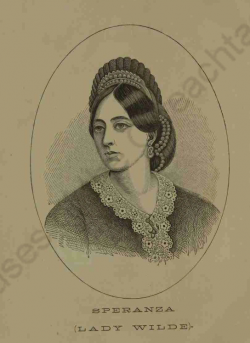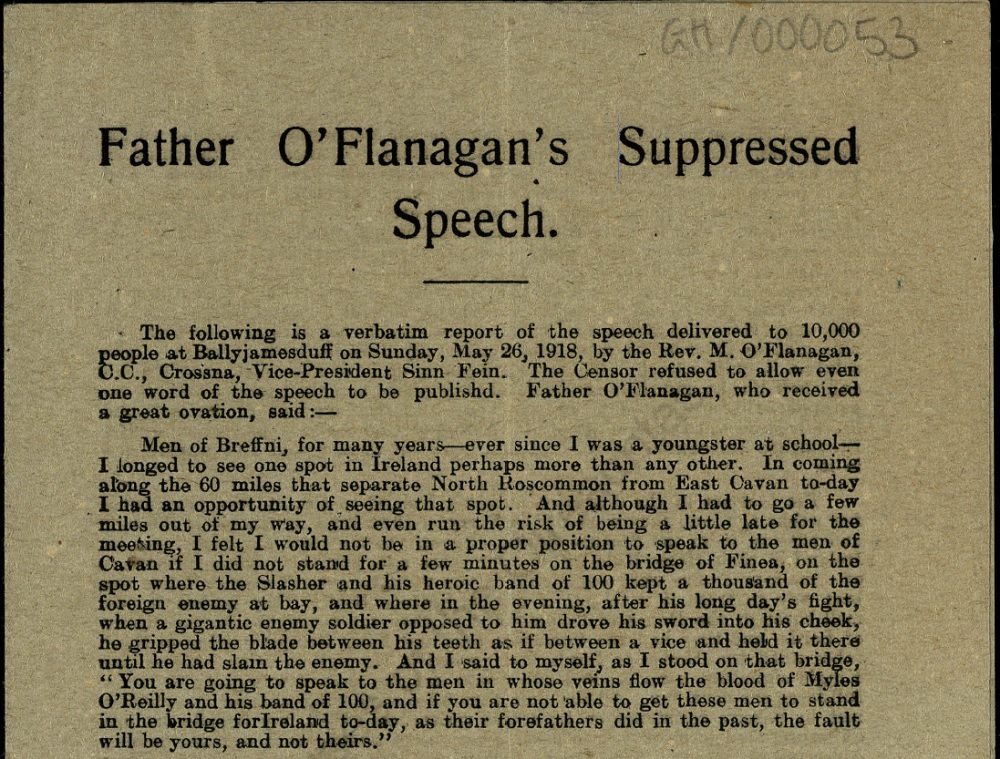The Oireachtas Library & Research Service exhibits selected treasures from the Oireachtas collection in a display case in Leinster House. Check back for updates and information on these unique artefacts.

December 2022
This month, to mark the centenary of the Free State Constitution, the Oireachtas Library is displaying The Irish Constitution, Explained by Darrell Figgis, alongside other texts by Figgis.
Darrell Figgis was a well-known literary figure with a keen intellect and his many published works include poetry, novels, plays, literary criticism, art criticism and journalism.
A member of the Irish Volunteers, Figgis participated in the plot to smuggle German rifles into Howth harbour via Erskine Childers’ sailing yacht, the Asgard. Figgis did not participate in the Easter Rising but was interned in several British prisons between 1916 and 1919. His experience in Reading Gaol is relayed in his memoir A Chronicle of Gaols.

Darrell Figgis arriving for the Treaty debates in January 1922, a few months before he became chair of the Constitution committee. Photo: Independent News And Media/Getty Images)
A free democratic constitution: the 1922 Constitution committee
The first constitution of the Irish State came into being in 1922. Arthur Griffith appointed Figgis as acting chair of the Constitution committee, standing in for Michael Collins. The committee produced three self-contained constitutions for review by the Provisional Government. Figgis’s The Irish Constitution contains a draft and an explanation, including chapters on "What is a constitution?" and "The People as Law-Makers."

The draft texts were then subject to consultation by the Provisional Government and brought before the British Government for revision. An amended text was agreed, and published by the Provisional Government on 16 June 1922, the day of the 1922 General Election. This text formed part of Constitution of the Irish Free State (Saorstát Éireann) Act, 1922. The Constitution of the Irish Free State (Bunreacht Shaorstáit Éireann) was adopted by Act of Dáil Éireann sitting as a constituent assembly on 25 October 1922.

From left to right: R. J. P. Mortished (Secretary), John O’Byrne, B.L.; C. J. France, Darrell Figgis (Acting Chairman), E. M. Stephens, B.L. (Secretary); P. A. O’Toole, B.L. (Secretary); James MacNeill, Hugh Kennedy, K.C.; James Murnahan, B.L.; James Douglas. (Prof. Alfred O’Rahilly and Kevin O’Shiel, B.L. were absent from the Session). Photo courtesy of Project Gutenberg.
"Poor Darrell Figgis lost his nice red beard"
Figgis served as an Independent TD for Dublin County in the 3rd and 4th Dáil from 1922-1925. His pro-Treaty stance in 1922 put him at odds with the Sinn Féin party and the IRA. It resulted in an assault on Figgis at his home on Fitzwilliam Street, where he lived with his wife Millie, and where members of the IRA cut off his prized beard.
Almost 30 years later, Bob Briscoe, who later became Lord Mayor of Dublin, gave an account of the attack:
Figgis started making some very detrimental remarks about the IRA. We did not consider him a menace -- but he annoyed us with his waspish stings . . . some of us held him tipped back on his swivel chair while one man produced a glittering razor. Figgis squealed like a pig ... I think he would have been happier if we had just cut his throat.
His political career halted when he was forced to resign from the Dáil committee established to examine proposals to develop broadcasting in the state. It was alleged that he had business associations with the owner of a commercial company who had eyes on obtaining the contract.
Darrell Figgis died in 1925, aged 43. He is buried in West Hampstead Cemetery in London.
Related texts by Figgis in the Oireachtas digital library
A Short Plot: A Sidelight on Political Expediency
Further article
The Short and Tragic Life of an Irish Dandy (from Independent.ie)
References
The Irish Free State Constitution Act 1922 (Session 2) was an Act of the Parliament of the United Kingdom, passed in 1922 to enact in UK law the Constitution of the Irish Free State, and to ratify the 1921 Anglo-Irish Treaty.
The papers of the Constitution Committee are held by the National Archives of Ireland.
Dáil Éireann debate, Wednesday, 18 Oct 1922 – Constitution of Saorstát Eireann Bill.
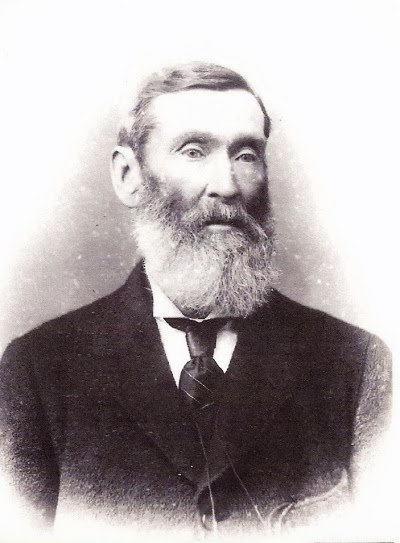
Source: Masterofmalt, CC BY-SA 4.0 via Wikimedia Commons
September 2022
'The oppressions and cruelties of Irish revenue officers'
This month the Oireachtas Library is displaying an 1818 pamphlet entitled Oppressions and cruelties of Irish revenue officers. Written by Reverend Edward Chichester, justice of the peace for Donegal, the somewhat paternalistic pamphlet contained accounts of harsh and unfair treatment of his parishioners by revenue officers, particularly in the barony of Inishowen.
According to the testimonies, officers were routinely soliciting bribes and falsely accusing people of illegal distilling.
The acting inspector-general of excise Aeneas Coffey took great offense at Chichester’s accusations, issuing his own pamphlet soon after. A distiller himself, Coffey defended the integrity of his officers and stated that the excise law was supported by the majority of the population. Chichester issued another pamphlet to counter Coffey’s response, again emphasising the impoverished situation of many of his parishioners, and the unfair application of the law by revenue officers.

Aenaes Coffey, distiller and inspector general of excise. Source: Masterofmalt, CC BY-SA 4.0 via Wikimedia Commons
Just what was going on? As income tax would not be introduced in Ireland until the 1850s, revenue was reliant on indirect taxation such as excise and customs duties. Whiskey had been subject to excise duty since the mid-17th century, but tax collection in Ireland was extremely disorganised and began to come under increasing scrutiny from the late 18th century. Private distilling was very common and not subject to a licence as long as the amount produced was low, so it was a shock when the laws changed to enforce both the registration of a license (which meant paying the excise duty) and a minimum size for stills. It became almost impossible for small stills to procure licenses and hundreds of them subsequently moved underground.
In poorer rural areas such as Donegal, tenants often used the profits from distilling to pay their rents, whether through the sale of grain or the alcohol itself. Given the high level of illegal distilling it was sometimes in the financial interests of revenue officers to take bribes for looking the other way. To make matters worse, fines were often levied at an entire townland or parish, punishing the innocent along with the guilty. Where people were unable to pay, officers seized animals or furniture, and landlords themselves sometimes stepped in to cover the fines. This led to an unusual situation in Ireland where landlords and tenants found themselves united against the revenue office. This was particularly the case in Donegal, where an 1806 report estimated that one out of every two houses had its own still.
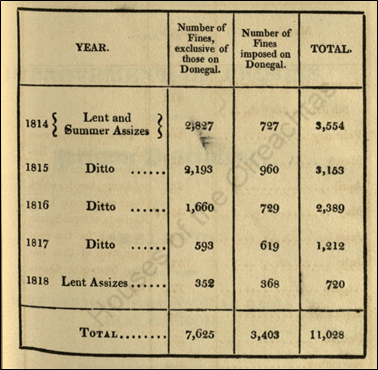
A return of the number of fines imposed on parishes and townlands between 1814 and 1818, with separate figures for Donegal
Tensions over the issue grew to the point where revenue officers who went ‘still-hunting’ could find themselves facing violent resistance. They insisted on armed escort from the military, but the soldiers generally disliked the duty, as they considered it too low a priority to warrant a risk to their lives (and they were consumers of the poitín themselves). Eventually a dedicated revenue police was formed and had some success in the townlands in which they were concentrated. But once they left an area, private stills were immediately reinstated, and illegal distilling would remain rife until the mid-1800s.
Provenance
These pamphlets are from the former ministerial Irish Office in London. A large pamphlet collection was transferred from London to the Oireachtas Library in the 1920s.
References
Dawson, N. (1977). Illicit distillation and the revenue police in Ireland in the eighteenth and nineteenth centuries. Irish Jurist, vol. 12, no. 2, pp. 282-294.
Kanter, D. & Walsh, P. (2019). Taxation, politics, and protest in Ireland 1662-2016. Palgrave Macmillan.

Houses of the Oireachtas
July 2022
“We felt…that a Census ought to be a Social Survey, not a bare Enumeration”
This month, following the initial release of official population counts in the 2022 Census, the Oireachtas Library is displaying a report of the 1841 Census. The preliminary results of the 2022 Census show that the population of Ireland has reached 5,123,536, marking the highest level since before the Famine.
After rapid growth in the early 19th century the population had reached 8,175,124 in 1841 (with 6,528,799 in the counties that now form the Republic). There was a much more modest increase between 1831 and 1841 than between 1821 and 1831. Explanations for this included the exclusion of army staff stationed in the country, the high rate of emigration and the inconsistent standards applied in 1821 and 1831. Though the numbers have long been contested for these early 19th century counts, the 1841 Census did go further than previous ones to record more detail about Irish society, using a standardised form and being conducted over a shorter period of time.
The Census recorded the number of dwellings in Ireland at 1,328,839, with 52,208, or 3.9%, uninhabited (The preliminary 2022 Census results show a vacancy rate of 7.8%). Dwellings were divided into four classes, the lowest, or fourth class, comprising mud cabins with just one room. 43.5% of rural families and 36.7% of urban families were living in the fourth class of accommodation, with nearly the same proportion again living in the third class. The map below shows the distribution of accommodation quality, with the darker shades indicating the lower classes. The extent of poor accommodation standards in Ireland was remarked upon in the final report.
The Census also recorded important information about education, trades and occupations, emigration, and livestock. There was even an estimate of tree coverage in the country.
The first full Census of Ireland was in 1821 and was conducted once a decade up to 1911. Reports like the one displayed here are particularly important as little remains of the original 19th century forms. The returns for the 1841 Census were destroyed along with those for 1821, 1831 and 1851 in the fire at the Records Office of Ireland in 1922. The returns for 1861 and 1871 were destroyed shortly after collection, and the returns for 1881 and 1891 were pulped for spare paper during World War I.
Provenance
This document is from the Dublin Castle Collection, the reference library of the former Chief Secretary’s Office at Dublin Castle. This was transferred to the Oireachtas Library in 1924.
References
Central Statistics Office. Census through History.
https://www.cso.ie/en/census/censusthroughhistory/
Moroney, Michael (2015). The 1841 Census – do the numbers add up? History Ireland [online], 23(3).
Houses of the Oireachtas
June 2022
This month, the Oireachtas Library is marking 100 years since the destruction of the Public Records Office of Ireland (PROI) with a display of an 1819 report by the Committee of Observation on the Public Records of Ireland.
“The history of a country is founded upon its archives.” Herbert Wood, Deputy Keeper of the Public Record Office of Ireland
A commission to investigate public record-keeping specifically in Ireland emerged from a wider British survey in the early years of the 19th century. Referring to “the state of disorder and confusion into which the records of the principal repositories of Ireland had fallen” the report outlined the poor physical conditions of repositories around the country, the messy arrangement of materials and lack of catalogues and indexes.
Despite the committee’s recommendations for improvements, it was not until 1867 that public record-keeping was centralised to a great extent in a dedicated Public Records Office in the Four Courts complex in Dublin. This complex was occupied by anti-Treaty IRA forces in April 1922.
On 28 June the Free State army began shelling the buildings, marking the first day of the Irish Civil War. On the morning of 30 June, an explosion of ammunition onsite caused a fire to spread rapidly, resulting in the devastating loss of administrative records dating back seven centuries.
This report is from the Dublin Castle Collection, the reference library of the former Chief Secretary’s Office, which has been in the Oireachtas Library’s possession since 1924. As this collection – much of which has been digitised - contains copies of some items once housed at the PROI, the library is sharing content with the Beyond 2022 project in Trinity College Dublin.
Beyond 2022 is gathering duplicate digital content from around the world to reconstruct the PROI as an open access virtual record treasury, which will be launched on 30 June 2022.
Provenance
These documents are from the Oireachtas Library’s Official Publications collection.
References
Wood, Herbert. “The Public Records of Ireland before and after 1922.” Transactions of the Royal Historical Society 13 (1930): 17–49.
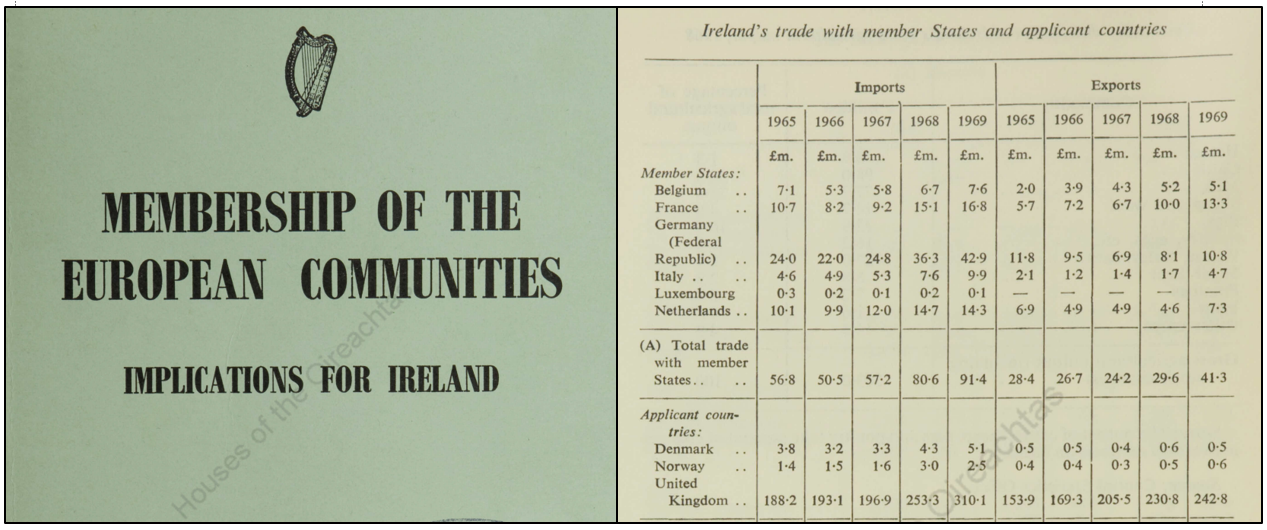
Houses of the Oireachtas
By the 1960s increased economic and political ties between Western European countries had formalised into three European Community organisations that would be a founding pillar of the European Union. The most prominent of these was the European Economic Community (EEC). At the same time Irish governments were taking a more active approach to opening and invigorating the long-stagnant Irish economy. The prospect of expanded trade and investment with a large swathe of continental Europe was an appealing one.
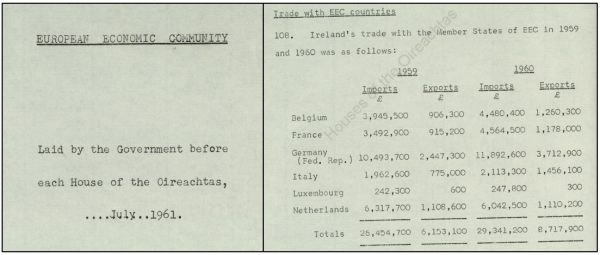
Ireland initially applied for membership of the EEC in 1961 along with the United Kingdom. The heavy dependence of Ireland on the UK market ensured that their membership applications remained intertwined throughout the process. As the 1961 White Paper noted:
“The attitude which has been adopted consistently by the Government to the question of Ireland's participation in the E.E.C. or a wider European grouping, is that primary regard must be had to our national interest and that while this would in certain circumstances, be served by our joining a grouping of which the United Kingdom was a member, it would not be served by joining the E.E.C, if the United Kingdom remained outside and we had to forgo our preferential advantages, in that market.”
The applications stalled in 1963 after objections to UK membership by Charles de Gaulle in France. They were reactivated in 1967, and after de Gaulle’s resignation in 1969, the path was clear to begin negotiations. The 1970 White Paper outlined the main implications of membership on issues such as agriculture, fisheries, taxation, free movement and equal pay. The report concluded that despite the challenges of the transition the national interest would be best served by entry to an enlarged EEC which included the UK.

Ireland signed the accession treaty on 22 January 1972. As the move required an amendment to the Constitution, a referendum was held in May, and was approved with over 83% of the vote.
For more on Ireland’s role in the European Communities/European Union, see this timeline prepared by the Oireachtas Library & Research Service.
Provenance
These documents are from the Oireachtas Library’s Official Publications collection.
References
O'Driscoll, M. (2013). Ireland through European Eyes: Western Europe, the EEC and Ireland, 1945-1973. Cork University Press.

Graham Horn. Source: Wikimedia Commons. License: CC BY-SA 2.0
April 2022
This month the Oireachtas Library is marking 50 years of Raidió na Gaeltachta with a display of RTÉ’s annual report from 1973. The report, covering the period of April 1972 to March 1973, outlines the inaugural year of programming at the new station, which broadcast for the first time on Easter Sunday, 1972.
Irish language programming was featured on Irish radio from the 1920s, and the concept of a dedicated station was suggested as early as 1926 by the Minister for Posts and Telegraphs J J Walsh. However, it was not until the late 1960s and after much campaigning by the Gaeltacht Civil Rights Movement and others that plans were finally made to establish a radio service for the Irish language community.
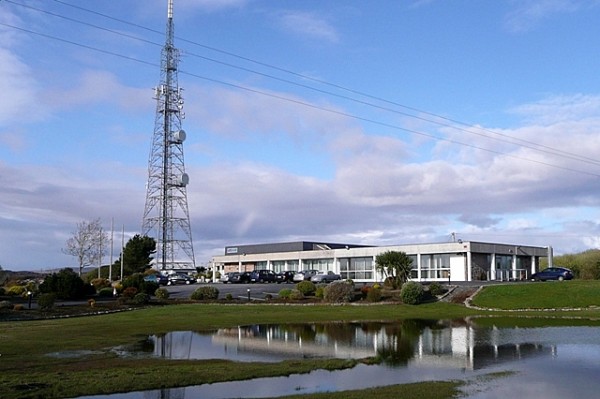
A headquarters was built in Casla, Co. Galway, with two further studios in Baile na nGall, Co. Kerry and Doirí Beaga, Co. Donegal. The station’s initial broadcasts were limited to the Gaeltacht regions but RTÉ’s annual report describes the ongoing technical work to extend the transmission throughout the country.
In terms of programming, magazine shows were running on Mondays, Wednesdays and Fridays from each of the three studios, with a focus on reconciling the different regions with different dialects. The report also mentions that the different dialects were less of a barrier than had been expected. The vast majority of content came from the Gaeltacht areas, with the noted exception of folk music. In addition to the magazine shows, the station broadcast dramas, regional current affairs and educational content.
Provenance
This document is from the Oireachtas Library’s Official Publications collection.
References
RTÉ. Local Radio Service for An Ghaeltacht, 1972. https://www.rte.ie/archives/2017/0228/856014-raidio-na-gaeltachta/
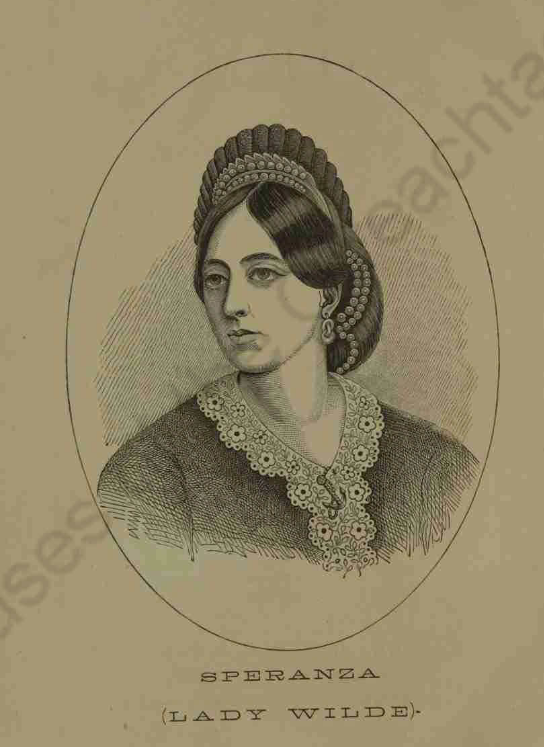
March 2022
This month the Oireachtas Library is marking International Women’s Day by displaying an 1871 book of poems by Jane Wilde. Born in 1821, Lady Wilde was a polyglot, essayist, poet, Irish nationalist and advocate for women’s rights.
“Fainting forms, hunger-stricken, what see you in the offing? Stately ships to bear our food away, amid the stranger’s scoffing”
She began writing poetry in her 20s for the Nation newspaper, under the pen name Speranza, the Italian for hope. One of her most famous poems was the 1847 ‘The Famine Year’ (first published as The Stricken Land’), a scathing rebuke of the British government’s failure to prevent famine in Ireland following widespread potato blight.
In addition to political causes Wilde was very interested in folklore and myths, contributing to the Celtic cultural revival of the late 19th century. She held literary ‘salons’ at her homes in Dublin and London. She was also very close to her famous son, Oscar, and a significant influence on him.
Though she supplemented her income through writing, Wilde fell into poverty in her later years trying to support herself and her other son William. She was denied permission to visit Oscar in Reading Gaol before she died in February 1896 and was buried in an unmarked grave at Kensal Green Cemetery. In 1999 a monument to her was erected in the cemetery by the Oscar Wilde Society.
Provenance
This book is from the Oireachtas Library’s York Street Workmen’s Club collection, which was donated to the library in the early 1920s. According to a note on the book, this copy was originally presented to the Workmen’s Club by Archbishop Thomas Croke.
References
Dudley, O. D. (2009) ‘Wilde, Jane Francesca Agnes (‘Speranza’)’. Dictionary of Irish Biography.
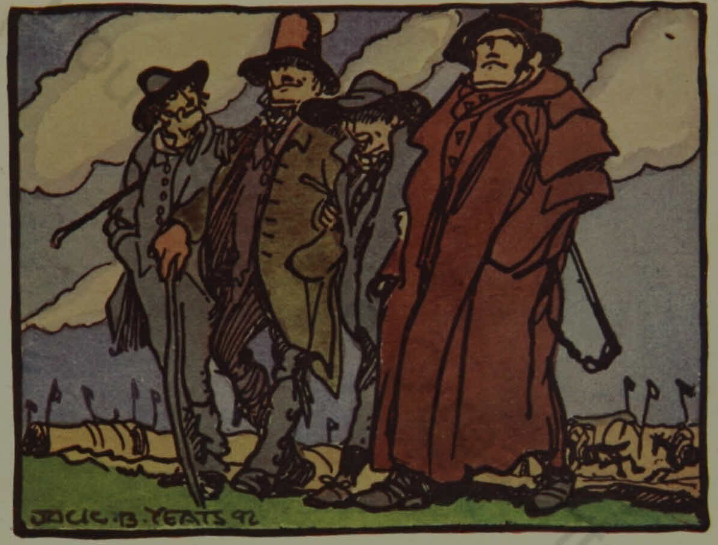
February 2022
This month we are displaying an exhibit of the travel book Rambles in Ireland. Published in 1912, the book recounts a trip taken by the writer Robert Lynd and his wife through Galway, Clare, Limerick, Kerry, Cork, Tipperary, and Dublin.
“Do you not think,” said I, resolved to turn the conversation at all costs, “that Parnell was a better man? “Parnell?” he barked, in an incredulous voice. “O God no. Oh, my God, no…”
Born in Belfast and based in London, Lynd worked as a journalist, essayist and editor. He was a staunch Irish nationalist and an active member of the Gaelic League. The book on display here was part of a ‘Rambles’ series of international travel essays published by Mills & Boon. It is beautifully illustrated throughout with drawings by Jack B. Yeats and photographs from the Lawrence photography studio.
The Sportsmen, by Jack B.Yeats
Though full of vivid descriptions of the Irish countryside and coastline, Lynd wasn’t particularly interested in scenery on his travels - “Going to see scenery always seems to me to be like taking an introduction to some famous man, not for the sake of a reasonable conversation, but for the sake of having met him”. He was far more interested in the social events of the towns and cities he visited. There are many entertaining and good-humoured interactions with locals and other tourists.
Lynd’s nationalist politics were sometimes challenged. At the Puck Fair in Killorglin he was offered a stool outside a local shop by the owner, who insisted on showing him a much-loved photo book of the King and Queen of England:
“Grand man, that!” said my host, tapping a freckled finger on the royal portrait [of King Edward].
“Do you not think,” said I, resolved to turn the conversation at all costs, “that Parnell was a better man?”
“Parnell?” he barked, in an incredulous voice. “O God no. Oh, my God, no,” he said, as though the very suggestion choked him with disgust.
“I can tell you,” he declared, his eyes dancing, as he snapped Queen Alexandra’s photograph-album out of my hands, “there’s damned little nationality in my bones. Maybe there would be,” he glared, retreating into the door of his shop, “if it paid me.”
The Puck Fair in Killorglin, from the Lawrence photography studio
Lynd also attempted to speak Irish throughout his trip but was sometimes met with puzzled or sheepish reactions from people. He was crushed when the proprietor of a bar in Killorglin asked if he was English when he ordered a drink in Irish. And on learning that he and his wife were ‘Gaelic Leaguers’, a priest in Lisdoonvarna announced “Ah! Bó – a cow: I got that far. It’s a terrible hard language. Do you think it will ever be spoken again?”
Finishing in Dublin, Lynd’s nationalism remained undiminished, however, and he concluded that “Dublin to-day is only leading a bathchair existence compared to the leaping energy of life that will be hers when she is a capital in liberties and duties as well as in name”.
The book provides a fascinating insight into not just the Irish tourist industry of 1912, but the immensely diverse political and social views of Irish citizens just a few years before war and revolution took hold.
Provenance
This book is from the Oireachtas Library’s Dublin Castle Collection, the former reference library of the Chief Secretary’s Office in Dublin Castle.
References
Ferriter, D. (2009) Lynd, Robert Wilson. Dictionary of Irish Biography.

December 2021
This month we are displaying a photographic facsimile of the Anglo-Irish Treaty. According to a handwritten note on the first page, the Articles of Agreement were copied by the National Museum (where the original Treaty is held), by permission of the government and under the supervision of the clerk of the Dáil.
The Treaty had been signed on 6 December 1921 after an intense period of negotiations in London. One of those providing secretarial assistance to the Irish delegation was Diarmuid O’Hegarty. Born in Skibbereen in 1892, O’Hegarty had joined the Civil Service in Dublin in 1910 and worked for T.P. Gill in the Department of Agriculture and Technical Instruction.

He also joined the Irish Volunteers and took part in the Easter Rising. Though jailed in England along with many other Volunteers he was accidentally released from prison and returned to his job in Ireland. According to his fellow Volunteer Barney O’Driscoll, T.P. Gill said “Take your holidays first, Hegarty and report back. I hope you enjoyed the time you were fighting”.
He was dismissed by the civil service in 1918 for refusing to take the oath of allegiance. But his administrative skills were put to vital use as clerk of the first Dáil and secretary to the Dáil cabinet in the two years that they were on the run. He organised their meetings, recorded the minutes and was the central point of communications for the departments. A close friend of Michael Collins, he accompanied him to London during the Treaty negotiations. As a supporter of the final agreement, he continued his civil service career after the Free State was established but will always be remembered as the “civil servant of the revolution” (Pakenham, 1972).
More information on the Anglo-Irish Treaty can be found on our dedicated web page on the Treaty Debates.
Provenance
This document is from the Oireachtas Library’s archival collection.
References
Pakenham, F. A. (1972). Peace by ordeal. London: Sidgwick & Jackson Ltd.
Murphy, W. & Coleman, M. (2009). "O’Hegarty (Ó hÉigeartuigh), Diarmuid". Dictionary of Irish Biography. www.dib.ie/biography/ohegarty-o-heigeartuigh-diarmuid-a6802
Ruairc, Ó. P. Ó., Borgonovo, J., & Bielenberg, A. (Eds.) (2015). The Men Will Talk to Me (Ernie O’Malley series, West Cork Brigade). Cork: Mercier Press.
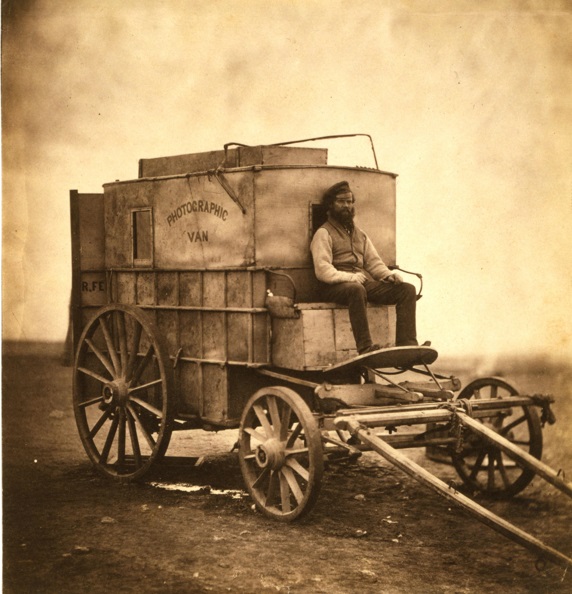
November 2021
This month we are displaying a copy of Nolan’s Illustrated History of the War against Russia. This was published shortly after the 1853-56 Crimean War, which Russia lost to a coalition of the United Kingdom, France, Sardinia, and the Ottoman Empire.
New technologies had a significant impact on media coverage of the war. Where previously it took weeks and months for reports to arrive from abroad, developments in telegraph communications meant that news could reach Britain within days, or even hours.
Times correspondent William Howard Russell (1820-1907) sent back vivid and sometimes scathing reports of the British military which had a major influence on public and political opinion. By 1855 the war had become unpopular in Britain, being associated with blunders like the infamous ‘Charge of the Light Brigade’ and the loss of more soldiers to disease than combat.

1) Fenton’s assistant Marcus Sparling, sitting on his photographic van. 2) Soldiers posed around a fire. Source: Wikimedia Commons
The war was also the first to feature the new technology of photography, most notably the work of British photographer Roger Fenton (1819-1869). Fenton travelled to Crimea in 1855, not as a journalist but to create a portfolio of images to sell at home. His equipment at the time was bulky and the long exposure times restricted his subject choices. Unable to capture live action on the battlefield, he also avoided graphic imagery of casualties, focussing instead on the military camps, equipment, and high-ranking officers.
Fenton also photographed the landscape and his most famous image of the war contained no people at all. Known as the Valley of the Shadow of Death the haunting image showed cannonballs strewn along a desolate road. Intriguingly, two versions of the same photograph exist, one with cannonballs on the road and one without. There has been much debate about which of the photographs was taken first, and whether Fenton staged the scene.
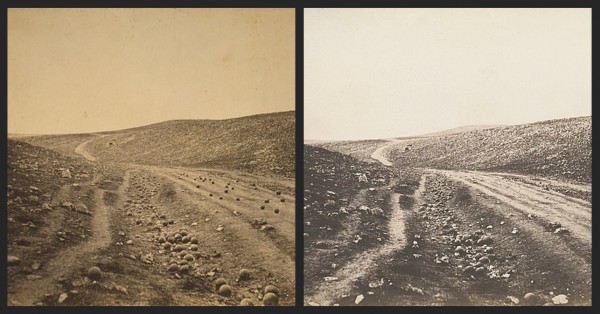
Two versions of Fenton’s Valley of the Shadow of Death. Source: Wikimedia Commons
Though not initially intended as news coverage, Fenton’s images were published in the Illustrated London News and attracted much attention from a public who had never experienced war in such an immediate and visual way. (They were also used for illustrations in Nolan’s book.) War photojournalism became commonplace as technologies improved, with both the press and the military vying for authority over the visual record of events. Disputed images such as Fenton’s Valley of the Shadow of Death or Robert Capa’s The Falling Soldier from the Spanish Civil War raise interesting questions about ‘truth’ and ‘reality’ in photography, and photojournalism continues to generate controversy over its perceived influence on public and political opinion.
Provenance
This title is from the Oireachtas Library’s FitzGerald Collection, purchased in auction in the 1920s from Carrigoran House, Co. Clare.
References
Baldwin, G., Daniel, M. & Greenough, S. (2004). All the mighty world: the photographs of Roger Fenton, 1852-1860. Yale University Press.
Britannica, The Editors of Encyclopaedia (1998). Crimean War. Encyclopedia Britannica. www.britannica.com/event/Crimean-War

October 2021
This month we are displaying a first edition of Rev. William Neilson’s An Introduction to the Irish Language, also known as Neilson’s Grammar. The book was first published in 1808 and is considered a pioneering text on Irish grammar and word structure.
William Neilson (1774-1821) was born into a scholarly, Irish-speaking Presbyterian family in County Down.
He was fluent in Latin, Greek, Hebrew and Irish and became a minister and teacher like his father. He taught Irish at his interdenominational school in Dundalk. Though he was loyal to the English crown his similarity in name to United Irishman Samuel Neilson (1761-1803) once caused him to be arrested for treason during the 1798 rebellion after he delivered a sermon in Irish. (He was released once he had provided a translation.
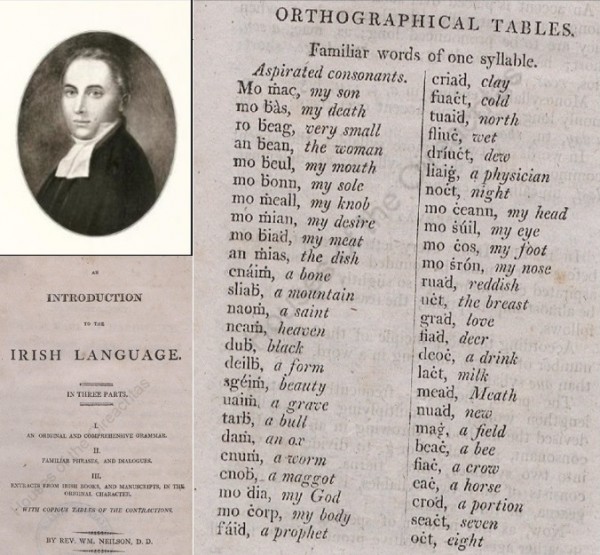
For the Presbyterian ministry use of the Irish language was encouraged as a means of spreading their religious message in Ireland. But there had also been a scholarly resurgence of interest in Celtic culture in Scotland and Ireland in the late 18th century. Scholars and antiquarians, some of whom had Scots Gaelic ancestry, advocated strongly for the preservation of Irish as essential for reading Gaelic manuscripts and other important historical documents.
Other scholars focused on promoting the use of Irish as a modern language. Neilson believed that a knowledge of Irish was vital simply for practical, everyday interactions with his own countrymen. It was for this reason that he produced his grammar book in 1808, noting that while a number of texts had been published on Celtic antiquities, “a grammar, by which the learner might be taught to compose, as well as to analyze, appeared to be wanted”. Presbyterian scholarly engagement with Irish continued into the 19th century but interest declined as the language became more politicised and associated primarily with the nationalist movement.
Provenance
The book has been part of the Oireachtas Library’s general historical collection since 1924.
References
Ó Saothraí, Séamas (1989). William Neilson DD MRIA (1774-1821). Journal of the County Louth Archaeological and Historical Society, 22 (1), 20-28.
Murphy, David (2009). Neilson, William (Mac Néill, Uilliam). Dictionary of Irish Biography.

William Cobbett, circa 1831. Source: Wikimedia Commons
September 2021
This month, we are displaying an entertaining account of the 1831 trial of William Cobbett (1763-1835).
Cobbett was an English journalist and political activist who championed the rights of rural workers during the industrialisation of 19th century Britain.
From the late 18th century, a succession of ‘enclosure’ laws in England saw the large-scale removal of traditionally common rural land into private ownership. This left a significant number of workers without any land to graze animals, meaning they were heavily reliant on wages as farm labourers during autumn and winter harvesting. The end of the Napoleonic wars, however, led to a decline in wages, as the returning men and an influx of Irish immigrants caused a labour surplus. This was compounded by a fall in agricultural prices, the burden of Church tithes and pressure on Poor Law rates for an increasing number of struggling people.

William Cobbett, circa 1831 / Source: Wikimedia Commons
When threshing machines began to replace the workers entirely, it sparked a widespread backlash. After two consecutive bad harvests, farm labourers had had enough by late 1830 and began to riot, attacking farms and destroying threshing machines. Threatening letters sent by the protesters to local authorities and wealthy landowning farmers were often signed by the name ‘Captain Swing’, thought to be inspired by the swinging motion of a flail (a tool for threshing grain). The riots therefore became known as the Swing Riots.
Cobbett had made an enemy of both Tory and Whig governments on many occasions by championing political reform and speaking out against political corruption and the rise of national debt. He particularly opposed industrialisation, harbouring the nostalgic view of a self-sufficient, 18th century agricultural England. His publications and speeches on the subject were popular with the rural community and his support for the Swing rioters led to a prosecution for seditious libel in 1831.
Cobbett represented himself in court. The trial opened with a complaint by the prosecuting Attorney General that Cobbett had packed the courtroom with cheering supporters and announced in front of the jury that “if truth prevail, we shall beat them”. It is clear from the published account that Cobbett’s provocative interactions with both the Attorney General and the presiding judge was a source of much frustration. His aggressive approach was successful, and to the government’s embarrassment he was acquitted when the jury failed to agree a verdict.

After the passing of the 1832 Reform Act, Cobbett was elected to parliament, but he found the move from activist to politician difficult. He died in 1835. Cobbett was a prolific writer throughout his life and is credited with coining the term ‘red herring’. His varied stances on key political and economic issues of the day made him friends and enemies on all sides of the political spectrum. He began publishing Parliamentary Debates in 1802 before financial difficulties prompted him to transfer ownership of the collection to Thomas Curson Hansard (1776-1833), after whose name the parliamentary record would become officially known.
Provenance
This publication is part of the Oireachtas Library’s Irish Office collection, a series of pamphlets once held in the reference library of the Irish Office, London, and transferred to the Oireachtas in the 1920s.
References
Caprettini, Bruno, and Hans-Joachim Voth (2020). "Rage against the Machines: Labor-Saving Technology and Unrest in Industrializing England." American Economic Review: Insights, 2(3), 305-20.
Wells, Roger (1997). “Mr William Cobbett, Captain Swing, and King William IV.” The Agricultural History Review, 45(1), 34–48.
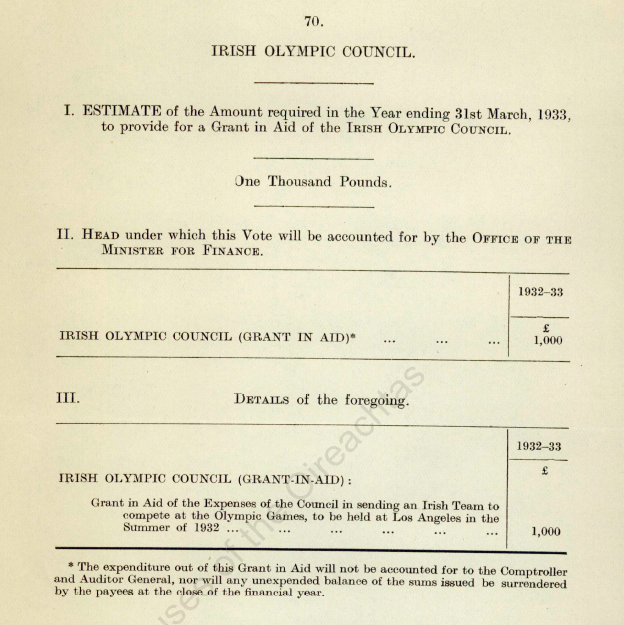
August 2021
This month, to celebrate the recent success of the Irish Olympic team in Tokyo, the Oireachtas Library has been looking through our collections for references to past games. This document laid before the Houses shows a grant of £1,000 from the Department of Finance to support the Irish team in the 1932 games in Los Angeles. In the Dáil on 9 June 1932, Minister for Finance Seán MacEntee explained that a precedent had been set by granting £1,000 to the team in 1928. When Deputy Richard Mulcahy asked about progress in having the sports of handball and hurling included as Olympic contests, MacEntee replied:
“Handball is not an item in the contests this year, but a team is being sent out. It is on trial, so to speak. I understand that steps have been taken to secure the same status with regard to hurling, but the suggestion has not advanced yet to the same stage as in the matter of handball. It is much more expensive to send out a hurling team than a handball team, and that may have had something to do with the attitude of the Olympic Council.”
Ireland had competed at the 1924 Paris Olympics but didn’t win any sports medals (though we won silver and bronze in the Olympic art competitions that were a feature until 1948). Around that time a medical student called Pat O’Callaghan was inspired by the strong tradition in Irish throwing sports to take up the hammer. Going from strength to strength in competitions, the young doctor became a national hero in 1928 when he won gold at the Amsterdam games, marking Ireland’s first Olympic medal as an independent country.

A government grant of £1,000 to support the Irish team at the 1932 Olympics
Eight athletes were sent to Los Angeles in 1932, including O’Callaghan and Bob Tisdall, the son of Irish parents, who lived in Britain. An impressive all-round athlete, Tisdall wrote to the Irish Olympic Council asking to take part in the 400m hurdle race, despite having never competed in it. Though running slowly in his first Irish trial, he managed a qualifying time after two weeks training in Ballybunion and was able to join the national team.
Initially struggling with nerves, Tisdall went on to win his heat and semi-final. On 1 August, he lined up for the final against very experienced athletes, including the reigning and preceding champions. Starting well, he smashed into the final hurdle but recovered in time to win the gold medal. Tisdall then made his way to the hammer circle, where he helped a frustrated O’Callaghan file down the spikes on his shoes. O’Callaghan had come in as one of the favourites, but his technique was impacted by the unexpectedly hard surface of the hammer circle. With his spikes filed down, and in second place for his final throw, he sent the hammer 5ft further than the leading competitor, retaining the gold medal for Ireland.
Dr Pat O’Callaghan (left) in 1928 and Bob Tisdall (right) in 1932
O’Callaghan became an international sporting celebrity in the years that followed. Political wrangling among rival athletic associations on the island meant that Ireland did not compete in the 1936 Olympics, so he could not defend his title. He later went to America, where he was offered the part of Tarzan in Hollywood. He made an unsuccessful attempt to move into professional wrestling before returning home, where he set up a general practice in Tipperary. Also maintaining an international celebrity status, Tisdall embarked on a range of business ventures over the following decades, living in Europe and Africa before finally settling in Australia. He did his first parachute jump at 86, and in 2000 he jogged with the Olympic flag at the age of 93 for the Sydney games.
References
Byrne, K. (2012). Monday 1 August 1932: Ireland's finest Olympic hour? History Ireland, 20(4), 28-29.
Lysaght, Charles (2010). Tisdall, Robert Morton Newbury (Bob). Dictionary of Irish Biography.
Rouse, P. (2009). O’Callaghan, Patrick (‘Pat’). Dictionary of Irish Biography.

July 2021
This month we are displaying an 1807 pamphlet by Reverend William Liddiard (1773–1841), calling for the establishment of an organised lifeboat service along the Irish coast. Reverend Liddiard was particularly keen to use the recently constructed Martello towers as dedicated lifeboat stations.
Liddiard was writing in response to the recent sinking of two ships in Dublin Bay - the Rochdale and the Prince of Wales - which saw the loss of almost 400 lives in one night.
“I have seized the moment when the feelings of the nation are afloat, and before they can possibly be thought to have subsided, of recommending a more general establishment of the Life-boat; a plan, which affords in some degree a balm for the despondency of the moment, promising as it does to prevent a recurrence of misfortunes similar to those, which have lately gloomed our shores."

The two ships had been carrying soldiers bound for the Napoleonic war front when they left Dublin on 19 November 1807. They were caught in a fierce wind and snowstorm shortly after setting out. The Prince of Wales was forced onto rocks at Blackrock, with the captain, crew, family members and two soldiers managing to reach shore on a smaller boat. 120 soldiers drowned. There was an allegation that the captain had trapped the soldiers below deck so that he could take the only spare boat to safety, but without enough evidence the charge was dropped. The Rochdale went onto the rocks at Seapoint, with the loss of all 265 passengers and crew.
It is clear from the pamphlet that Liddiard was impressed with the work to develop a dedicated lifeboat service at Bamburgh Castle on the north-east coast of England. In 1786 the estate’s trustee, the Archdeacon of Northumberland, commissioned Lionel Lukin (1742-1834) to transform a fishing boat into a specialised lifeboat. Lukin had been credited with the first design for an onshore lifeboat, patented in 1785. For several years afterwards sea rescues were launched in Lukin’s converted fishing boat by a crew out of Bamburgh Castle, making it one of the first dedicated lifeboat stations.
The organised nature of the work at Bamburgh prompted Liddiard to ask if the ‘Mortello’ towers around the Irish coast “might not be converted into a twofold means of safety, into a tower of salvation as well as what it now is, a battlement of defence?”. Many of the buildings – more commonly known as Martello towers – had been built in 1804 and 1805, taking their name and design from defensive towers at Mortella in Corsica.
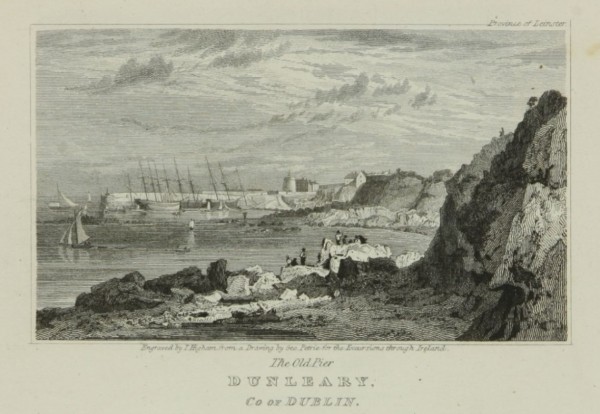
The old pier at the village of Dunleary
Despite Liddiard’s impassioned plea, however, it was not until 1824 that the National Institution for the Preservation of Lives and Property from Shipwreck was established for Britain and Ireland (now the Royal National Lifeboat Institution). But the sinking of the Rochdale and Prince of Wales added to a growing campaign for the development of a safe pier at the small village of Dunleary (now Dún Laoghaire). A pier built in the mid-1700s had silted over, but the location was considered ideal as a harbour for ships seeking refuge from the dangerous conditions of Dublin Bay. Work on this finally began in 1817, and the new pier was finished in time to host the ship of King George IV in 1821.
Provenance
This 1807 pamphlet is from the Oireachtas Library’s Dublin Castle Collection, the former reference library of the Chief Secretary’s Office in Dublin Castle. The image of Dún Laoghaire is from Thomas Cromwell’s 1820 Excursions Through Ireland, which is part of the Milltown Collection, the former library at Russborough House, Co. Wicklow.
References
Royal National Lifeboat Institute. (n.d.) Timeline. https://rnli.org/about-us/our-history/timeline.
Bourke, Edward J. (2008). “The Sinking of the Rochdale and the Prince of Wales.” Dublin Historical Record, 61(2), 129–135. JSTOR, www.jstor.org/stable/27806786.

June 2021
This month we are taking a closer look at the Parnell Commission of 1888-89 through contemporary cartoons published in the pro-Parnell newspaper United Ireland.
In the 1880s The Times, a conservative newspaper, was vehemently opposed to the push for home rule in Ireland by the Liberal Party and the Irish Parliamentary Party (IPP). In March 1887 the paper started publishing a series of articles called "Parnellism and Crime", which sought to discredit the IPP by linking its members directly to criminality and republican violence.
On 18 April the paper caused a sensation by publishing a letter, allegedly written by IPP leader Charles Stewart Parnell, in which he indicated support for the notorious 1882 murders of the Chief Secretary and Permanent Under-Secretary for Ireland. Parnell protested his innocence, claiming that this and other published letters were forgeries. A year later the government established a special commission to investigate the numerous charges made by The Times against Parnell and his peers.
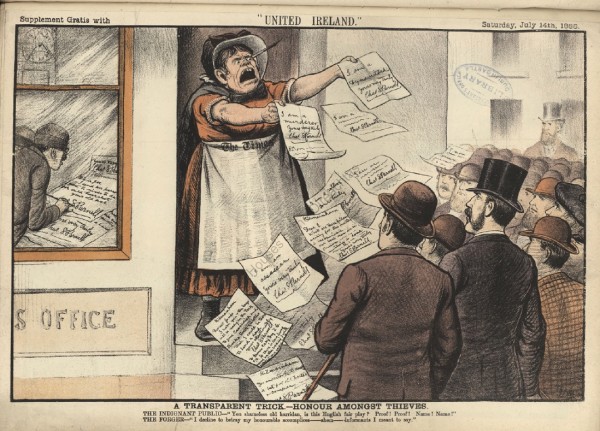
In this cartoon The Times, depicted as a woman wearing the newspaper as an apron, throws fake Parnell letters towards an indignant public, while through a window people can be seen copying Parnell’s signature.
The government viewed the commission as an opportunity to permanently damage Parnell’s reputation, and by association the reputation of the Liberal Party. The government provided significant resources and documents to The Times’s solicitors and The Times was represented by the Attorney General at the commission. Parnell accepted it as an opportunity to clear his name. His friends at the United Ireland newspaper in Dublin rallied to his support, publishing editorials and cartoons depicting The Times as being mired in forgery.
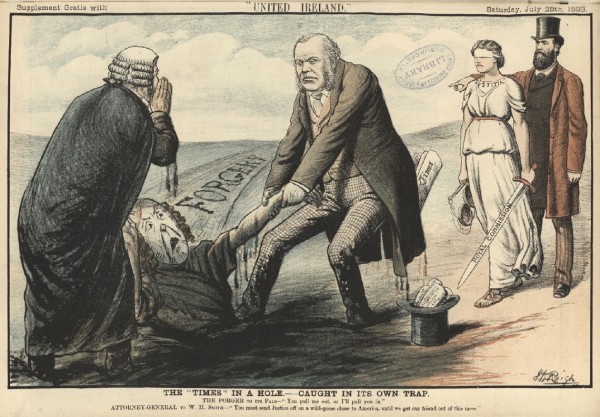
In this cartoon The Times is depicted as a woman with the face of a clock. She is being pulled from a hole by the Attorney General and W.H. Smith, Leader of the House of Commons, while Parnell points them out to a blindfolded "Justice".
It was over a month before the hearings turned to the letters. The Times said that the letters had been purchased from a unionist organisation - the Irish Loyal and Patriotic Union. This organisation claimed to have purchased them from a man called Richard Pigott. Pigott was a disreputable and down-on-his-luck Irish journalist. He was well known to Irish nationalists and land activists, having fallen out with many of them over the years. Pigott took to the witness stand on 20 February 1889 and told the commission that he had sourced the letters from the republican group Clan na Gael in Paris.
Parnell’s team, led by the future Lord Chief Justice of England, Charles Russell, had conducted its own detailed research and they had noticed something unusual about the letters. There were a surprising number of spelling mistakes, including the word 'hesitancy' spelled as 'hesitency'. A political friend of Parnell’s, Patrick Egan, remembered seeing that particular spelling error before, in a letter sent to him by Richard Pigott. Egan alerted Parnell and Russell, and when it was time to cross-examine Pigott on the witness stand, Russell handed him a piece of paper.
He asked the perplexed witness to write out several words, including the name ‘Patrick Egan’. Then he added casually, “There is one word I had forgotten. Lower down, please, leaving spaces, write the word ‘hesitancy’, with a small ‘h’". Pigott wrote this final word and handed the sheet of paper back to Russell. Sure enough, the word ‘hesitancy’ had been spelled as ‘hesitency’. Russell put the sheet down and proceeded to bombard Pigott with questions.
Russell and the team had seen correspondence from Pigott to the Archbishop of Dublin (a supporter of home rule and land reform), warning him of impending press revelations about Parnell. The correspondence had raised their suspicions that he was playing unionists and nationalists against each other for financial profit. Pigott’s increasingly flustered answers to Russell’s detailed questions demonstrated quite visibly that he was lying about his involvement in the affair. On the third day that he was due for questioning, Pigott didn’t appear, having fled abroad. He sent a written confession to the commission that he had forged the letters himself. When police caught up with him in Madrid, he died by his own hand before they could arrest him.
The commission eventually upheld some lesser charges against the IPP. But in relation to the accusation of direct links with violence and criminality, Parnell was vindicated. He sued The Times and his political reputation was restored. Just a few months later, however, he was thrust into the media spotlight again when he was named as a co-respondent in the divorce proceedings of William and Katharine O’Shea. This time the outcome would be very different.
Provenance
The cartoons ‘A Transparent Trick’ and ‘The Times in a Hole’ are from the Oireachtas Library’s Dublin Castle Collection, the former reference library of the Chief Secretary’s Office in Dublin Castle.
References
Aitken, R. (Spring, 2003). The Spelling Game: Russell’s Cross-Examination of Pigott. Litigation, 29(3), 47-71.
Lyons, F. (1974). 'Parnellism and Crime', 1887-90. Transactions of the Royal Historical Society, 24, 123-140.
Wellman, F. L. (1903). The art of cross-examination. London. Macmillan.
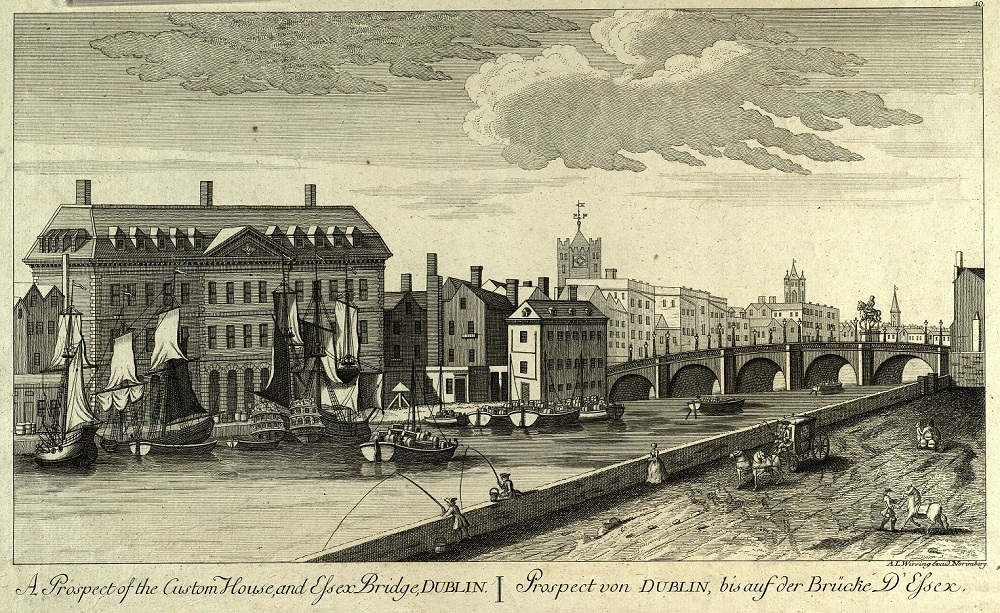
May 2021
This month, to mark 100 years since the burning of the Custom House, Dublin, we are displaying an 18th century print of the former Custom House beside Essex Bridge. The Custom House was designed by architect Thomas Burgh and built in 1707.
The 18th century was a time of great expansion and development in Dublin. The Wide Streets Commission, a powerful planning organisation, shifted the entire centre of the city eastwards, away from the old medieval quarter.
The Commission built and widened streets and bridges, creating a new central artery from Sackville Street (now O’Connell Street) through to College Green.
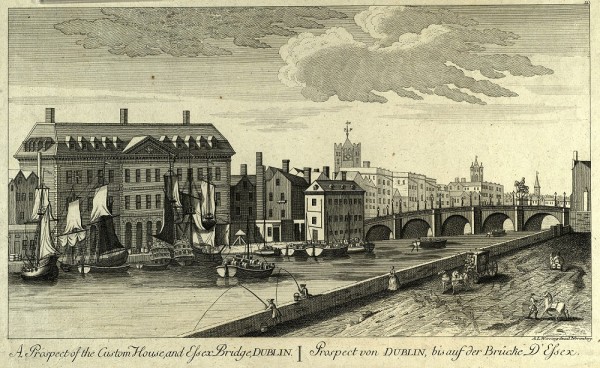
Print of the 1707 Custom House beside Essex Bridge
By the 1770s, the Custom House’s location was deemed unfit for purpose. The Wide Streets Commission and Commission of Revenue decided to develop a new Custom House further down river. The plans caused uproar amongst local merchants, who worried that their businesses and property values would be negatively impacted. The Oireachtas Library has an anonymous pamphlet from 1781 which argued that the new location would provide a deeper berth for a greater number of ships.
Chief Revenue Commissioner John Beresford invited architect James Gandon from London to design the new Custom House. Constructed in the popular neoclassical style of the time, the impressive building opened in 1791. Gandon also designed the Carlisle Bridge (now O’Connell Bridge), which opened in 1794 and shares some architectural features with the Custom House.

A 19th century sketch of Gandon’s Custom House
As the port of Dublin moved further down river in the 19th century, the location for the Custom House became unsuitable again. Instead, it housed a number of other government agencies, including the Local Government Board. As a symbol of British administration, it was deemed a target by the IRA during the War of Independence.
On 25 May 1921 a large force of IRA volunteers stormed the building. They set a fire that would last five days, gutting the interior and destroying centuries of government records. The shell of the building survived, and it was restored in the late 1920s (and again in the 1980s) by the Office of Public Works. Today the building provides offices for the Department of Housing, Local Government and Heritage.
Provenance note
Both the print of the 1707 Custom House and the pamphlet are from the Oireachtas Library’s Dublin Castle Collection, the former reference library of the Chief Secretary’s Office in Dublin Castle. The print of Gandon's Custom House is from Whammond's Illustrated Guide to Dublin and Wicklow (1878), which is part of the general historical collection.
Further reading
James Kelly. "Beresford, John". Dictionary of Irish Biography. (ed.) James McGuire, James Quinn. Cambridge, United Kingdom: Cambridge University Press, 2009.
Development of Dublin City. www.archiseek.com/2010/development-of-dublin-city
Custom House, Dublin. www.archiseek.com/2010/1791-custom-house-customhouse-quay-dublin
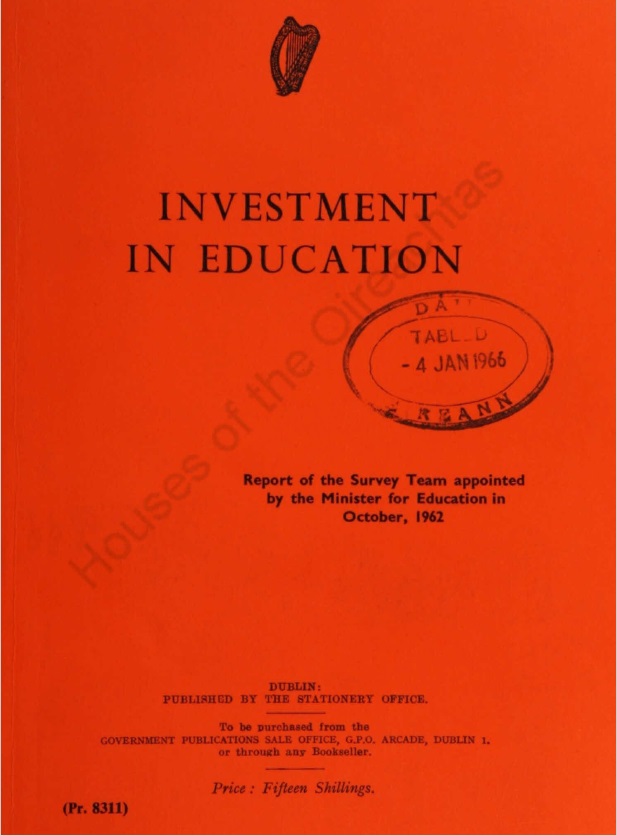
January 2021
To mark the UN International Day of Education this month we are displaying the seminal 1965 report Investment in Education.
When Seán Lemass became Taoiseach in 1959, he embarked on a rapidly modernising approach to Ireland’s economy, opening up opportunities for free trade, foreign investment and increased engagement with the international community.
Ireland was one of the founding members of the Organisation for Economic Co-operation and Development (OECD) in 1961 and was the first member to take part in its education investment and planning programme. With support from the OECD, a team was established in 1962 by Minister for Education Patrick Hillery to thoroughly survey the education environment in Ireland.
Published at the end of 1965, the final report presented the first comprehensive statistical data on the Irish education sector. It found that thousands of Irish children were not moving on to second level education, and a significant proportion of those that did were leaving before completing the intermediate certificate. The main impediments highlighted were fees, geographical location and transport, lack of resources, and class issues.
These were worrying statistics in light of projected growth in the Irish population and economy, and the report became a powerful evidence base for the policies of incoming Minister for Education Donogh O’Malley in 1966. On 10 September that year he caused a media storm by announcing at a National Union of Journalists event that the Government would introduce free second level education and a free transport scheme for students from remote areas.

Minister for Education Donogh O’Malley, 1967
The scheme, though implicitly supported by Lemass, had not yet been approved by Cabinet, and caused some controversy amongst his colleagues. But faced with positive public support and the stark statistics of the Investment in Education report, the Government set about implementing this enormously progressive change in Irish education.
References
Patrick Maume (2009). O'Malley, Donogh. In James McGuire, James Quinn (ed.), Dictionary of Irish Biography. Cambridge, United Kingdom: Cambridge University Press.
John Walsh, Selina McCoy, Aidan Seery & Paul Conway (2014). Investment in Education and the intractability of inequality, Irish Educational Studies, 33:2, 119-122.

April 2021
This month the Oireachtas Library is marking 100 years since the appointment of the last Lord Lieutenant of Ireland by displaying a satirical 19th century cartoon about this unique role.
There had been an official administrative representative of the English king or queen in Ireland since 1172. The position was known by several terms including chief governor, lord deputy, lord justice and viceroy, but was officially termed the ‘Lord Lieutenant’ after the 1801 Act of Union.
The role decreased in importance after 1801, becoming more of a ceremonial position. Real administrative power lay with the Chief Secretary for Ireland, a government minister who, though subordinate to the Lord Lieutenant, had more effect in implementing government policy. The Lord Lieutenant had apartments in Dublin Castle but mainly stayed in the Viceregal Lodge in Phoenix Park (renamed Áras an Uachtaráin when it became the residence for the President of Ireland). He hosted balls, dinners, royal visits, and the ceremonies for his political and military appointments.

As with the large number of absentee British landlords in the 19th century, the perceived aloofness of the Lord Lieutenant came to symbolise for many the administrative dysfunction of British rule in Ireland. None of the appointees held the role for longer than a few years, with the exception of the Earl of Aberdeen (a relatively sympathetic home rule advocate) between 1905 and 1915. Between 1880 and 1890, a time of much political and social unrest in the country, there were 7 different Lord Lieutenants.
They were much satirised in the nationalist press. The cartoon on display here from 1889 is called “Who’s to be king of the castle?” and demonstrates the ongoing debate about whether the role was a valuable political stepping stone or a burden to be avoided. The scene depicts a number of British peers in an auction room as ‘Dublin Castle’ is held aloft by the Chief Secretary Arthur Balfour. Parnell looks on, standing next to a doorway marked ‘Home Rule’. Lord Salisbury calls the Castle “a most desirable residence for any sporting gent”, while Lord Castlereagh says, “it is full of open sewers, and infested with rats”.
In spite of several debates in the Commons about whether or not to abolish the role, it survived into the 20th century. On 27 April 1921, Edmund FitzAlan-Howard (1st Viscount FitzAlan of Derwent) was appointed, the first Catholic to hold the post since 1685. He oversaw the implementation of the Government of Ireland Act 1920 and the Anglo-Irish Treaty, and the establishment of two home rule parliaments on the island of Ireland between 1921 and 1922. The post was officially abolished when the Free State came into being in December 1922, being replaced by the Governor-General of the Irish Free State. That role was abolished in 1936.
Provenance note: This cartoon is one of over 600 19th century political cartoons in the library’s Dublin Castle Collection. This was the former reference library of the Chief Secretary’s Office in Dublin Castle.
References
Duncan, Mark (1921). Ireland’s Lord Lieutenant: “a fount of all that is slimy in our national life”. Century Ireland. RTÉ. Retrieved on 16/04/2021 at: https://www.rte.ie/centuryireland/index.php/articles/irelands-lord-lieutenant-a-fount-of-all-that-slimy-in-our-national-life

March 2021
This month we are revisiting the long, dangerous search for a northwest shipping route through the Arctic by exhibiting Captain John Ross’s published account of his expedition between 1829 and 1833.
Though the Vikings had sailed quite far northwest in the 10th century, it wasn’t until the end of the 1500s that European colonial powers began a sustained search for a safe shipping passage around the tip of North America.
It was hoped that this new shipping lane would enable quicker expansion of trade routes with the east. No such passage had been established by the time John Ross set out on his second expedition in 1829. Ross’s ship – Victory – carried the captain, three officers and 19 crew. The previous winter had been unusually mild, leading to an early sense of optimism about the voyage.

Ross’s map of the Arctic region. ‘King William Land’ in the south was later discovered to be an island.
In addition to the overall goal of navigating through to the west coast of North America the journey was one of scientific, meteorological and ethnographic discovery. Captain Ross gave names to previously uncharted inlets, mountains and islands. Notes, sketches and specimens of wildlife were taken. Ross records in detail how the party traded metal and other materials with the local Inuit for food, dogs and assistance with hunting, even making a wooden leg for one Inuit man. The ship also came upon the abandoned wreckage of a previous expedition led by Captain William Parry in 1825.

The voyage had scientific purposes, and the crew took time to document the wildlife.
In September of their first year the ship became trapped in ice and was unable to make any significant retreat for the following three winters. Ross did his best to keep spirits up, both for the crew and for himself, but admitted in his journal that “amid all its brilliancy, this land, this land of ice and snow, has ever been, and ever will be, a dull, dreary, heart-sinking, monotonous waste, under the influence of which the very mind is paralyzed”.
The crew continued to make overland discoveries, recording the magnetic north pole in 1831. In 1832 the crushing ice forced them to abandon the ship completely, and they began making plans to use the smaller boats from Parry’s shipwreck to row themselves to safety. Exhausted and suffering from scurvy they set out in 1833 and were fortunate to be rescued by the whaling ship Isabella, the very ship that Ross had captained on his first northwest expedition in 1818.

An 1834 print by Edward Francis Finden showing the rescue of Ross’s crew by the Isabella.
Ross writes that on introducing himself to the first Isabella crew member “he assured me that I had been dead two years”. Safe on board he found himself so unused to a real bed that he couldn’t sleep, finding it easier to sit in a chair for the first night. As the expedition had been assumed lost forever, their return caused considerable excitement in British society. The surviving members (three had died) were compensated financially and Ross was knighted. He published his journals of the expedition in 1835.
Though a navigable route was identified in the 1850s, by the end of the 19th century no ship had successfully sailed through the northwest passage. In 1903 Norwegian explorer Roald Amundsen (who later became the first person to reach the south pole) set out in a light boat with a crew of just six. Though trapped in the ice for two years he successfully navigated the passage by 1906. The passage has never been of significant practical use for shipping, though in recent years the melting Arctic ice has renewed interest in its potential.
This book is from the FitzGerald collection purchased by the Oireachtas Library in 1922. This was a private family library and contains books and journals on literature, history and science.
References
Britannica, T. Editors of Encyclopaedia (1998). Sir John Ross. Encyclopedia Britannica. www.britannica.com/biography/John-Ross-British-explorer
Royal Museums Greenwich. John Ross’s second North-West Passage expedition 1829-33. www.rmg.co.uk/stories/topics/john-james-clarke-ross-north-west-passage-expedition-1829-33
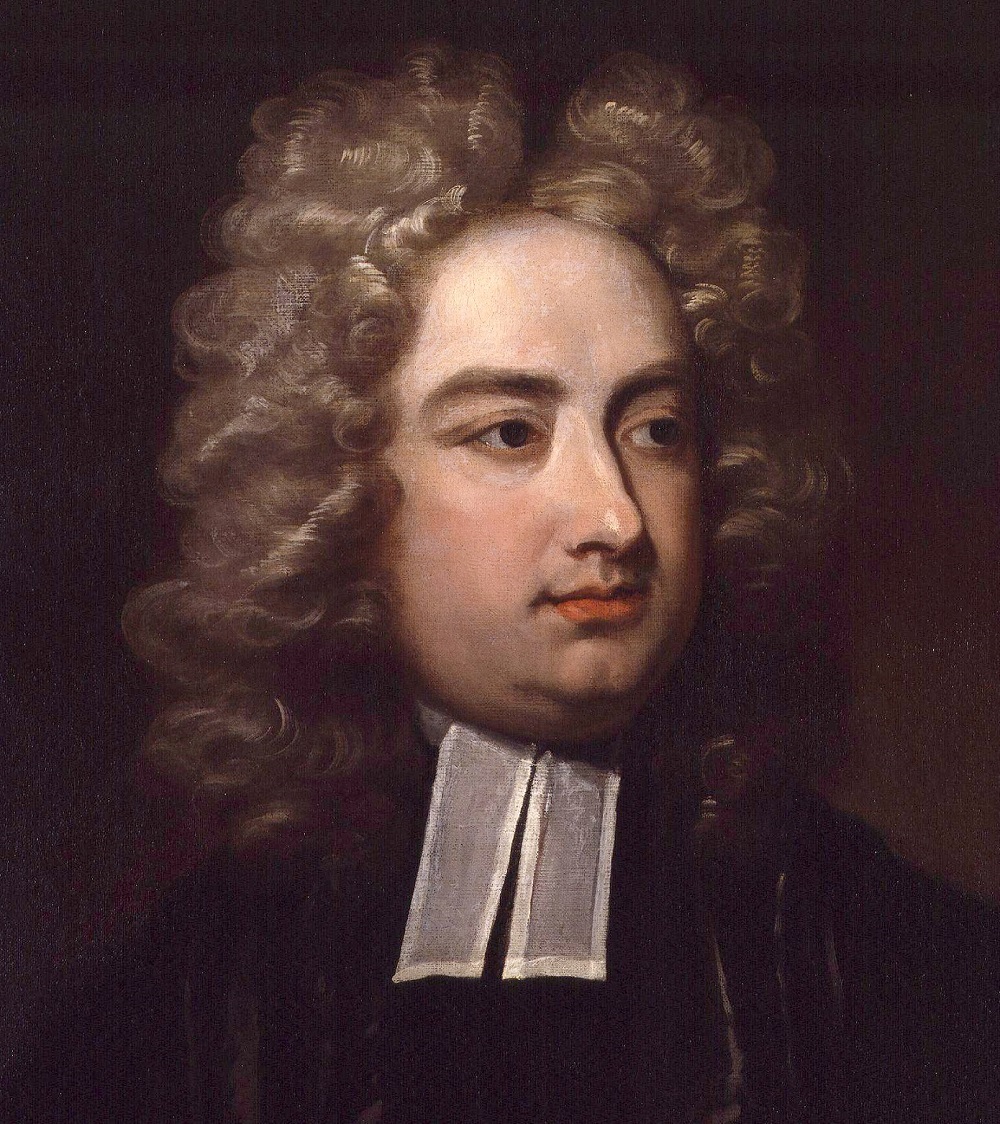
Jonathan Swift, by Charles Jervas
February 2021
This month we are revisiting the failed attempt to set up a national bank of Ireland 300 years ago with pamphlets for and against the proposal in our virtual display case.
The 17th century had brought about significant change in banking and finance, with the rise of joint stock companies and the establishment of national banks. The bank of England was founded in 1694 and immediately became a significant source of funds and debt management for the government. In 1720 a number of Irish MPs petitioned the King for a charter to set up a national bank of Ireland.
MPs like Henry Maxwell argued that the bank would guarantee lower interest rates than other private banks, which would increase the flow of money, fund capital projects and help Irish manufacturing and trade. Any improvements in the Irish economy, they proposed, could only be of benefit to both kingdoms. They also believed that a national Irish bank would leave investors less exposed to losses caused by foreign wars and stock bubbles.

Irish MPs Henry Maxwell and Hercules Rowley addressed each other’s arguments for and against the bank in a series of pamphlets
The charter was granted on the condition that the Parliament of Ireland pass an Act to set out rules for the bank within one year. But when the Parliament met to debate the Bill in late 1721 it was voted out after the first paragraph. Both Houses passed severe resolutions declaring not only that an Irish bank would be a national threat, but that anyone who pursued the idea would be considered an "enemy to his country".
Why was there such stringent opposition to a bank of Ireland? Scholars have pointed to anxiety on the part of the Protestant elite that Roman Catholics, who were forbidden to invest in land under the Penal laws, could accrue wealth alternatively by investing in the bank. There were also concerns that the bank could be used to fund England’s wars, as the Bank of England had done since its establishment. Shareholders in other banks may have worried that increased competition in the market would depreciate the value of their investments.
Of enormous concern was the prospect of political corruption, that the wealth of the bank would be used to buy elections or make corrupt investments. Perhaps the fear most openly shared, and certainly evident in the flurry of pamphlets published in the autumn of 1721, was a repeat of the South Sea bubble. The South Sea trading company, which had been backed by the English government, saw its share price soar and crash within the space of a few months in 1720, causing enormous losses for its wealthy investors.
It is clear from the pamphlets of MP Hercules Rowley that he considered the ills of the Irish economy to be the fault of laziness and vanity, and that a bank of Ireland would merely exacerbate those problems. Behind many of the MPs’ arguments lay a fundamental mistrust of modern banking, and of the risks inherent in Europe’s growing stock markets. Many of those who voted against the Bill were part of the rural gentry, the owners of vast estates who believed that real wealth should come from land, not trade.

Prominent writer Jonathan Swift is more famously associated with the “Wood’s halfpence” crisis of 1722-25 but was also opposed to the bank of Ireland
Public arguments about Irish finance would continue throughout the 18th century, many of them set out in pamphlets by prominent figures such as Jonathan Swift (who may have assisted the MPs with their pamphlets opposing the bank in 1721). The Oireachtas Library has eight pamphlets dealing with the 1721 crisis alone, which were bound and kept in the reference library of the Chief Secretary’s Office in Dublin Castle.
References
Rees, G. (Sep/Oct 2012). "Hang up half a dozen bankers": attitudes to bankers in mid-eighteenth-century Ireland. History Ireland.
Ryder, M. (1982). The Bank of Ireland, 1721: Land, Credit and Dependency. The Historical Journal, 25, 3, 557-582.

December 2020
This month we are displaying a print from the 1889 Christmas edition of United Ireland. Throughout the late 19th century nationalist papers like The Freeman’s Journal and United Ireland published special Christmas issues. The accompanying picture supplements were often highly illustrative, with romanticised images from history or idealistic images of the future.
In a departure from the regular cartoonist J.D. Reigh, this detailed illustration was by the British artist Walter Crane, with a central panel by Henry Halliday. Crane’s original work had been presented to former Prime Minister William Gladstone at the Liberal Club in London for his wedding anniversary in July of that year, and United Ireland had reproduced both works to celebrate his 80th birthday in December. It served as both a decorative celebration of Gladstone’s political reforms and as a vision of the future relationship between England and Ireland.

The title “Coming events cast their brightness before” was a play on the proverb “Coming events cast their shadows before”. Though he is now more associated with his designs for children’s books, Walter Crane was an active socialist who produced idealistic political imagery for a number of left-wing British publications and organisations.
In this picture Gladstone is depicted wearing the cross of St. George. He is using his axe of Home Rule to rescue Erin from a serpent representing tyranny, coercion and a range of other political and social evils. In the centre panel Erin and Britannia walk arm in arm.
Banners on either side celebrate Gladstone’s legislative reforms since the 1860s. Kathleen Ní Houlihan and "Pat" stand underneath the banners. Erin and Britannia are depicted again underneath the centre panel, holding hands and draped in a banner that reads, “Freedom for England & Ireland”.
The picture was a strikingly optimistic one for United Ireland to include as a Christmas supplement, considering political events of the previous years. Gladstone’s attempts to pass a Home Rule Bill had brought down his own government in 1886 and caused an irreparable split in the Liberal Party. But Gladstone’s support for an Irish parliament saw him increasingly depicted in nationalist papers as a heroic figure similar to Parnell.
The Oireachtas Library’s print has slight damage to the bottom left corner, and to the first stanza of the accompanying poem, which reads as follows:
May this bright vision all accomplished be
Ere Christmas comes again his cheery round
Two nations long at fiercest enmity
At last in bonds of fair affection bound.

Detail from the print in the 1889 Christmas edition of United Ireland
References
Hollander, J. A. (2000) Heroic Construction: Parnell in Irish Political Cartoons, 1880-1891. New Hibernia Review/Irish Éireannach Nua, 4(4), 53-65
McBride, L. W. (1998) Historical Imagery in Irish Political Illustrations, 1880-1910. New Hibernia Review/Irish Éireannach Nua, 2(1), 9-25
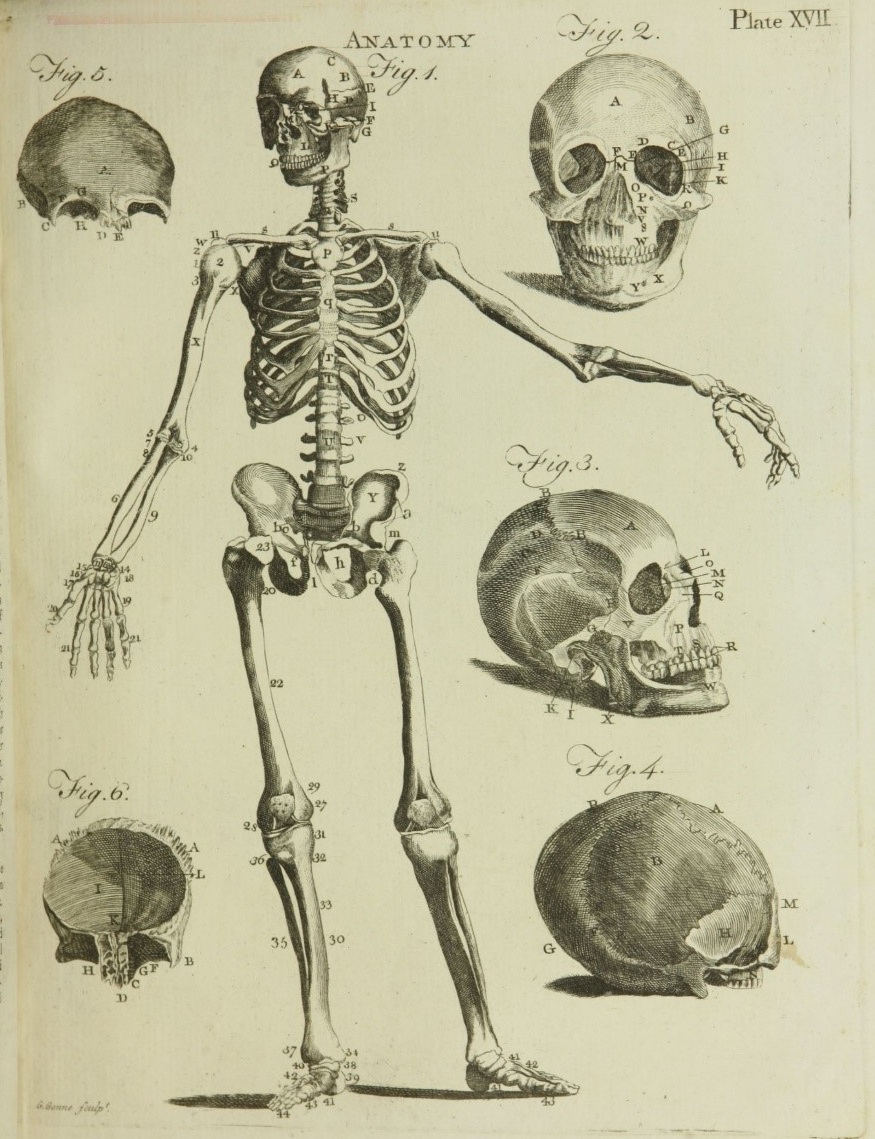
There were over 500 copperplates included in Moore’s edition of the Encyclopaedia, illustrating a selection of topics
November 2020
This month, to mark Science Week, we are exhibiting the first volume of our 3rd edition Encyclopaedia Britannica from 1790. The official edition was published in Edinburgh but the edition in the Library’s collection is a well-known pirated copy published by James Moore in Dublin.
The Encyclopaedia Britannica is the oldest English-language general encyclopaedia. It was first published in 1768. The multi-volume work laid out articles in alphabetical order on a variety of subjects from science and the arts. The content was either compiled from other publications or written especially by the editors and subject experts.
The 3rd edition of the Encyclopaedia introduced the exciting new science of aerostation, the study of aerial navigation. This section recounts a century of scientific experimentation, culminating in 1782 when two French brothers, Joseph-Michel and Jacques-Étienne Montgolfier, made a breakthrough. Taking inspiration from the rising effects of smoke, the brothers set out to create artificial ‘balloons’ of silk, linen and other materials, under which they attached little boxes. When they lit fires inside the boxes, the heated air filled the balloons and lifted them into the air.
The brothers soon found themselves demonstrating their flying machines to large audiences, and eventually to King Louis XVI and Queen Marie Antoinette. Building a decorative new balloon for the occasion, they attached a wicker basket with a live sheep, rooster and duck. These were, according to the Encyclopaedia, “the first animals ever sent through the atmosphere”. The balloon, though damaged by a gust of wind in the experiment, rose to a height of 1,440 feet, stayed suspended in the air for 8 minutes and then landed 10,200 feet away. The animals were unharmed. (Though not mentioned in the Encyclopaedia, Richard Crosbie was inspired by the Montgolfier brothers to become the first Irish aeronaut when he took to the air in a balloon over Ranelagh Gardens on 19 January 1785.)

Illustrations of early hot air balloons from Encyclopaedia Britannica, including those of the Montgolfier brothers
The Encyclopaedia Britannica became very popular in homes and educational settings, being viewed and trusted as a layman’s guide to general knowledge. But as scientific and other knowledge developed during the 19th and 20th centuries, it became difficult for editions to keep pace. Moving from a practice of publishing every 10-20 years to annual publication did little to help, as the fast turnaround meant that many subjects were left unrevised, sometimes for decades. Criticism mounted about outdated information, and particularly cultural and social biases.
The editors made several attempts to reorganise the structure of the content and experimented with new digital formats as they became available in the 1970s and 1980s. But sales declined considerably in the 1990s in competition with Microsoft’s Encarta and as the world wide web developed. Though the digital edition is still a popular subscription for schools and libraries, the final print edition was issued in 2010.
References
Auchter, D. (1999). The evolution of the Encyclopaedia Britannica: from the Macropaedia to Britannica Online. Reference Services Review, 27(3), 291-299.
Kafker, F.A. & Loveland, J. (2011). The publisher James Moore and his Dublin edition of the “Encyclopaedia Britannica”: a notable eighteenth-century Irish publication. Eighteenth-century Ireland/Iris an dá chultúr, 26, 115-139.
MacMahon, B. (2010). 'A most ingenious mechanic': Ireland's first airman. History Ireland, 18(6).
Stewart, E.D., Hardy Wise Kent, C., et al. (2020, October 20). Encyclopaedia Britannica.
www.britannica.com/topic/Encyclopaedia-Britannica-English-language-reference-work
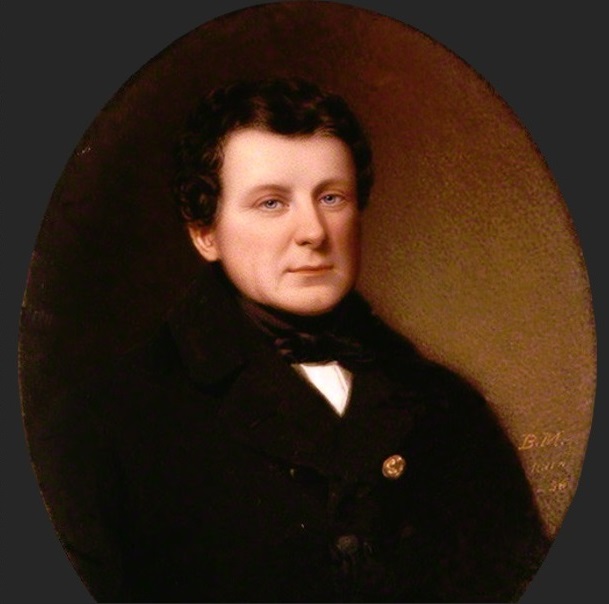
October 2020
This month we are exhibiting John O’Connell’s Repeal Dictionary, published 175 years ago by the Loyal National Repeal Association. Though officially titled ‘Part 1’, a second part was never compiled, so the politically charged dictionary only runs from A (for Absenteeism) to M (for Murder).

Daniel O’Connell, John’s father, organised the Loyal National Repeal Association in 1840 as part of his political campaign to repeal the 1801 Act of Union and restore an Irish parliament. As a charismatic speaker and politician, O’Connell soon attracted wide public support for the cause, in Ireland and in America. However, there was growing discontent amongst a younger generation of members who came to be known as the Young Irelanders. By the time the Repeal Dictionary was published in 1845, relations between the two groups were becoming particularly fraught.
The Young Irelanders distrusted Daniel O’Connell’s attempts to ally with the Whig party in return for Irish reforms. Many worried that such compromises would at best result in a devolved parliament with limited autonomy or at worst, in no political reform at all. At the same time, the pro-Catholic stance of the O’Connells alienated the Protestant members of the group. The Young Irelanders also held that armed struggle should be an option if all political attempts failed to establish home rule. The O’Connells, however, remained firmly opposed to violence.
Another area of disagreement between the two groups was that of slavery in America. The O’Connells were staunch abolitionists. But Young Irelanders argued that speaking out against slavery could cost the nationalist movement valuable support from America. The issue was compounded during the famine years, when, in the absence of help from the newly elected Whig government, famine relief was highly reliant on private donations from abroad. Daniel O’Connell was adamant that the Association should turn down 'blood-stained money' from slave-owning or pro-slavery Americans. He lent his signature to anti-slavery petitions, spoke publicly on the matter and met with prominent abolitionists like Frederick Douglass, who visited Ireland for several months in 1845.

Renowned abolitionist Frederick Douglass (left) was impressed by the anti-slavery rhetoric of Daniel O’Connell (right) when he visited Ireland in 1845
In the end, the issues proved unresolvable. Daniel O’Connell died in 1847. John O'Connell failed to heal the divisions in the Repeal Association and the Young Irelanders broke away to form the Irish Confederation.
References
Clarke, R. (1942). The relations between O’Connell and the Young Irelanders. Irish Historical Studies, 3(9), 18-30
Delahunty, I. (2013). ‘A noble empire in the West’: Young Ireland, the United States and Slavery. Britain and the World, 6(2), 171-191

September 2020
This month we are looking at attitudes to imperialism in its collection of Irish nationalist cartoons from the 1880s.
Two imperial enterprises of note in the 19th century were the so-called "Scramble for Africa" and the "Great Game". The latter term refers loosely to the diplomatic and military confrontations between Britain and Russia in central Asia, where Britain was keen to prevent Russian interests from encroaching on India. The "Scramble for Africa" denotes the period between the 1880s and 1914 when European countries partitioned about 90% of the African continent.
A game of brag, Weekly Freeman, 25 April 1885
Irish attitudes to imperialism in the 19th century were complex. Many Irish people served abroad in the military and civil administration of British-controlled territories. For some, there was great pride associated with being part of a mighty empire. People believed that "Western" influence could improve the lives of those in colonised nations or focussed on the benefits of expanded commercial and trade opportunities. For some Home Rule leaders, such as Isaac Butt, there was no mutual exclusivity between being an Irish nationalist and being part of the British empire. Others, such as Michael Davitt, were resolutely anti-imperialist.
Irish nationalist newspapers tracked British foreign policy intensely. When conflict broke out in colonies like Sudan and Afghanistan, newspapers followed quickly with reports, editorials and political cartoons. Attitudes were sometimes mocking of British military defeat, or revelled in the perceived weakness of Britain compared to Russia, as shown in the Weekly Freeman cartoons A game of brag and Outside the gate.
Outside the gate, Weekly Freeman, 2 May 1885
At other times, the cartoons displayed an empathy with foreign nationalists. This cartoon from the Weekly News shows Irish members of the British military reading news of unrest at home, while sympathising with Sudanese rebels as “men who are only defending their own country”.
Private McCarthy..., Weekly News, 28 February 1885
Nationalist newspapers strongly conflated the political and civil unrest of 1880s Ireland with suppression of nationalist movements in British colonies. Though there was often a sense of superiority over the peoples of Africa and Asia, the general view was that those nations should be able to decide for themselves how they were governed. Similar to the Irish cultural revival, anti-imperialist sentiment became a popular means for Irish nationalists in the late 19th century to further emphasise "difference" between Ireland and Britain.
Further reading
De Nie, M. (2012). "Speed the Mahdi!" The Irish Press and Empire during the Sudan Conflict of 1883-1885. Journal of British Studies, 51(4), 883-909.
Townend, P.A. (2016). The Road to Home Rule: Anti-Imperialism and the Irish National Movement. Madison, Wisconsin: University of Wisconsin Press.

August 2020
This month we mark 100 years since the passing of the Restoration of Order in Ireland Act (ROIA) by exhibiting a copy of the associated regulations. This set of regulations has handwritten amendments on the front cover and was kept in the office of Under-Secretary John Anderson at Dublin Castle.
ROIA essentially extended regulations under the Defence of the Realm Act 1914 (DORA). This wartime emergency legislation gave the government enormous social and economic control over civilians. Most controversially it allowed for the internment and court martial of civilians who acted or were planning to act in violation of national security.
After the war the regulations continued to be enforced in Ireland to thwart an increasingly confident republican movement. Intimidation and violence saw many quit the police force. People started refusing to give evidence in cases, making it difficult to convict members of Sinn Féin or the IRA. The newly declared Dáil Éireann even established its own court system.
By 1920 the government’s authority over Irish civil society was disintegrating but the Prime Minister was reluctant to declare martial law. The government chose to bolster the demoralised Royal Irish Constabulary by recruiting British ex-soldiers and officers. On 9th August parliament passed the Restoration of Order in Ireland Act. The regulations pertaining to this Act extended the jurisdiction of courts martial under DORA. The authorities hoped that an increased conviction rate for the IRA and Sinn Féin would dampen the conflict while they finalised plans to enact some form of home rule.
Convictions increased initially but application of the draconian regulations further alienated Irish civilians from government policy. The situation was exacerbated by the actions of an undisciplined police force and military. Reprisals and counter-reprisals escalated, culminating in the burning of a substantial portion of Cork City by British forces on the night of 11th December. By the close of the year the government had declared martial law throughout most of Munster.
References
Ainsworth, J. S. (2000). British Security Policy in Ireland, 1920-1921: A Desperate Attempt by the Crown to Maintain Anglo-Irish Unity by Force. Proceedings 11th Irish-Australian Conference, Murdoch University, Perth
Connell Jr., J. E.A. (July/August 2020). Restoration of Order in Ireland Act. History Ireland 28(4).

July 2020
This month we are highlighting an unusual pamphlet in our collection. Titled Infection, the document was originally published in 1867 but was re-issued by the author – Sir J. Clarke Jervoise – in 1882.
The pamphlet contains a passionate argument against the use of quarantine for the control of disease. For Clarke Jervoise, an MP at the time of the pamphlet’s first publication, the cruelty of isolation, particularly for the poor or elderly, was simply not worth the suffering.
There was (in his opinion) insufficient evidence that quarantine prevented illness from spreading.
Clarke Jervoise was, like many Victorians, a believer in the miasma theory of disease. This meant that disease was caused by bad air, made toxic through emanations from dead bodies or rotting vegetation. In the mid-19th century most people believed that disease could spontaneously generate, particularly in dirty, cramped conditions such as the homes of the poor. There remained a strong focus on sanitation and cleanliness in public health initiatives, even as legislation was being passed to enforce smallpox vaccination and quarantines for a range of infectious diseases.
 An 1831 artistic depiction of cholera spreading through the air, a prevailing theory until the 1860s
An 1831 artistic depiction of cholera spreading through the air, a prevailing theory until the 1860s
This emphasis on cleanliness was often intertwined with a moralising or patronising view of the poor. As Clarke Jervoise writes: “Good air, good food, and good habits, good lodgement, moderation, and cleanliness, which is next to godliness, will do more to stamp out disease than even if the Ark had been placed in quarantine”. For him, the physical "germ" was a myth, unproven by science. And the threat of "contagion", that of people passing on disease through close contact, was therefore completely overstated.
Interestingly the pamphlet is accompanied by “Remarks by Miss Nightingale”, though the cover page for this section is signed Anon and was certainly not updated since the first publication in 1867. In it the author claims that “the disease-germ-fetish, and the witchcraft-fetish are the produce of the same mental condition; both of them spring from the same source, a desire to group together a number of detached phenomena, so as to make a kind of raft on which weak minds can float”. Whether or not the words can be directly attributed to Nightingale, it is true that she was also a believer in the miasma theory. This was what led her to so fervently pursue cleanliness and ventilation in the hospitals where she worked. Her advocacy did help with the prevention and control of disease, though not for reasons she understood until much later in her life.
Between the time that Clarke Jervoise’s pamphlet was published and re-published something of a revolution had emerged in the understanding of infectious and contagious diseases. The work of Louis Pasteur, Robert Koch and others in the 1860s and 1870s not only identified the so-called mythical germs that caused specific diseases but demonstrated conclusively that these microorganisms could not spontaneously generate.
 Louis Pasteur circa 1895. His experiments heralded the "age of bacteriology", and the rise of the germ theory of disease
Louis Pasteur circa 1895. His experiments heralded the "age of bacteriology", and the rise of the germ theory of disease
By the end of the 19th century miasma theory fell away. A range of dangerous bacteria and viruses were identified, work began on new vaccinations with an understanding of how and why they worked, and antiseptics were pioneered by surgeons like Joseph Lister, drastically reducing patient mortality. There is evidence that Nightingale came to accept germ theory, while remaining a passionate advocate of cleanliness in hospitals. Whether Clarke Jervoise’s thoughts evolved on the matter is unknown but seems unlikely given the unchanged content in the 1882 re-issue of his pamphlet.
References
Halliday, S. (2001). Death and miasma in Victorian London: an obstinate belief. British Medical Journal 323 (7327), 1469-71.
McDonald, L. (Ed.) (2009). Florence Nightingale: The Nightingale school. Waterloo, Ontario: Wilfred Laurier University Press.
Storor, D. (1996). “Pestilence measured and registered”: Victorian sanitary reform and the moral ordering of urban space. Australasian Victorian Studies Journal, 2 (1), 56-64.
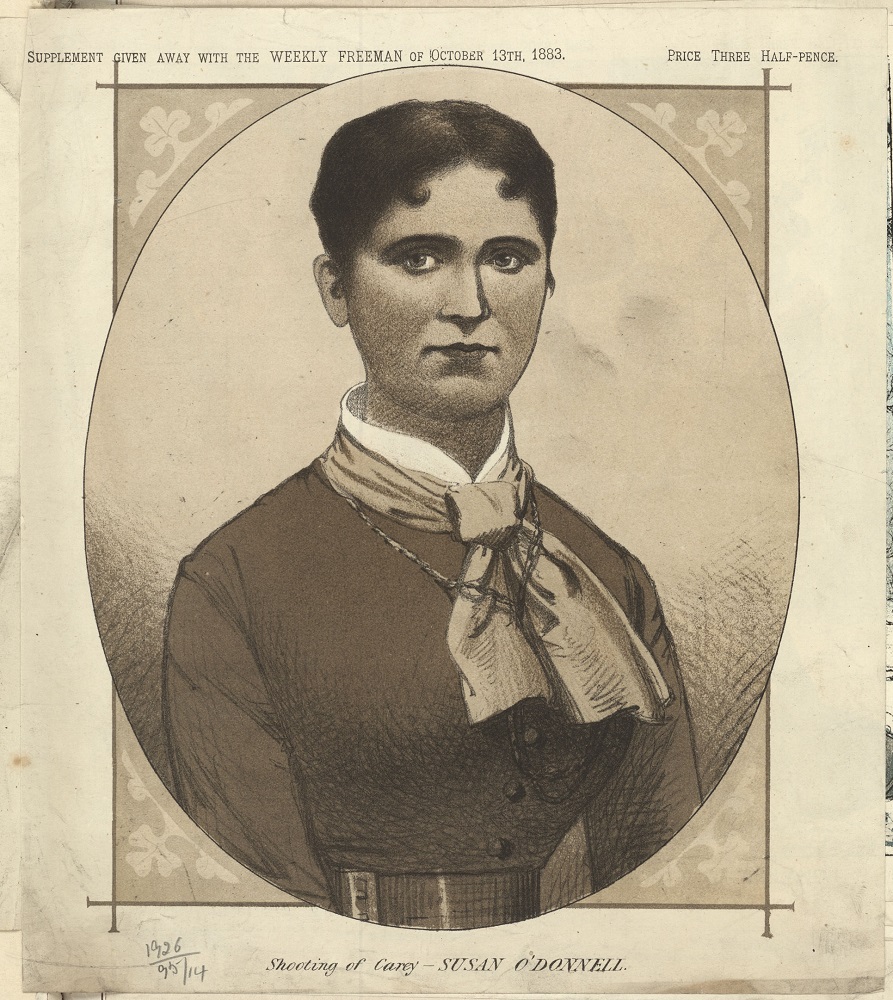
Susan O’Donnell
June 2020
This month we are highlighting a digital collection of political cartoons from the late 19th century. The Library has over 600 digitised cartoons from the nationalist newspapers Weekly Freeman, Weekly News and United Ireland that were held in the library of the chief secretary’s office in Dublin Castle. The cartoon on display shows Susan O’Donnell, the "wife" of Patrick O’Donnell, a Fenian sympathiser who shot dead the police informer James Carey in 1883.
On 6 May 1882 Lord Frederick Cavendish, the chief secretary for Ireland, and Thomas Henry Burke, permanent under-secretary, were murdered in Phoenix Park by members of the Invincibles, a nationalist group that had broken away from the Irish Republican Brotherhood.
A large police investigation was launched, and the police convinced several of the suspects arrested to inform on others. The most important informant was James Carey, whose damning testimony helped to convict and hang five men. Now an outcast in the nationalist community, Carey changed his name to Power and in July 1883 he sailed with his wife and children to Capetown, South Africa. He made little effort to remain incognito, and by the time he boarded a second ship in Capetown to travel onward to Natal, his real identity had become known.
One of Carey’s co-passengers was Patrick O’Donnell. O’Donnell was a nationalist and supporter of the Fenian cause who had lived in the US on and off since he was a child. In 1883, while living and working in his native Donegal, he decided to try his luck in South Africa, and he happened to travel on the same ship as James Carey to Capetown. Accompanying him was a young woman called Susan O’Donnell. O’Donnell referred to Susan at different times as his wife or niece, but her real name was reported later as Susan Gallagher, O’Donnell’s actual wife having remained in America when he returned to Ireland.
O’Donnell had befriended "Power" and his family on the journey, but on recognising him as the informer James Carey he shot him on the boat to Natal. There was great celebration by Irish nationalists around the world on hearing the news of Carey’s death. In Ireland bonfires were lit and effigies burned in the streets. O’Donnell’s subsequent trial received much attention, and inconsistencies in witness testimony resulted in stories (still debated today) that he had been sent by the Fenians to assassinate Carey. Nationalist funds were raised to help his defence. His lawyers argued that the shooting had been in self-defence, but he was found guilty of murder and hanged in December 1883, becoming something of a martyr for the nationalist cause.

Nationalist poster commemorating Patrick O'Donnell (Library of Congress)
References
McCracken, J. L. (Summer, 2001). The fate of an infamous informer. History Ireland, 9(2). https://www.historyireland.com/18th-19th-century-history/the-fate-of-an-infamous-informer/
Murphy, D. (2009). O'Donnell, Patrick. In McGuire, J. & Quinn, J. (ed.), Dictionary of Irish Biography. Cambridge, United Kingdom: Cambridge University Press.
Quinn, J. (2009). Carey, James. In McGuire, J. & Quinn, J. (ed.), Dictionary of Irish Biography. Cambridge, United Kingdom: Cambridge University Press.
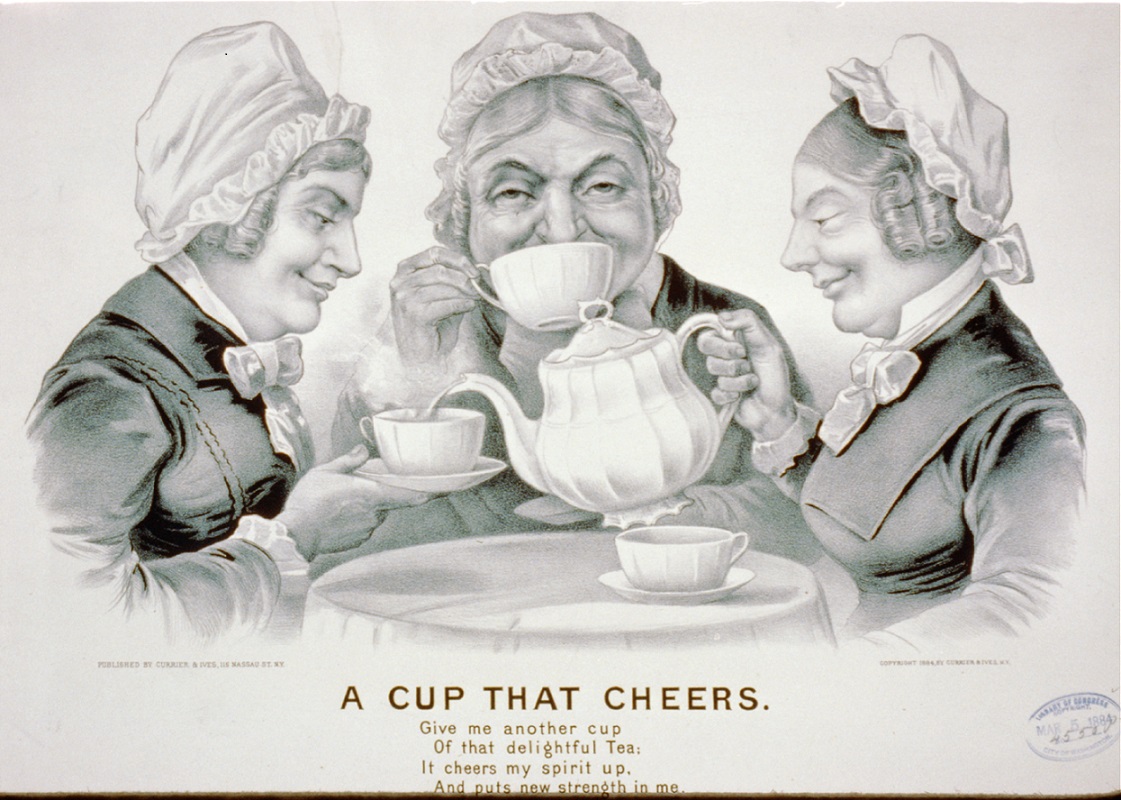
Currier & Ives (1884). A cup that cheers / Courtesy of the Library of Congress
May 2020
This month we are taking a look at an address by Dr. E. D. Mapother to the Statistical and Social Inquiry Society of Ireland in 1880. The speech was published and bound with other pamphlets as part of the reference library of the Chief Secretary’s Office in Dublin Castle.
The speech offers a fascinating overview of public health conditions in Ireland in the late 19th century.
In addition to discussing developments in housing, sanitation, registration and control of infectious diseases, Mapother discusses recent attempts to improve the quality and supply of food, water and milk. He bemoans the lack of cookery skills in Ireland and is critical of the increasing preference for white bread and tea amongst the urban poor. Mapother also derides the practice of afternoon tea, which he claims is causing "dyspeptic and nervous females" to seek help at medical dispensaries.

Currier & Ives (1884). A cup that cheers / Courtesy of the Library of Congress
Tea drinking had risen in popularity in the 19th century. For the British and Irish middle and upper classes, afternoon tea became a fashionable ritual associated almost exclusively with women. Tea drinking for them was governed by strict rules around preparation and serving. This was in contrast to poor urban and rural households where tea was "stewed" in a pot all day. Its consumption came to be viewed as excessive and indulgent, not unlike the way that potato consumption had been viewed before the Famine.
The price of tea fell in the late 19th century, putting the substance at easier reach for the lower classes. The number of shops rose as well, especially in rural areas, making tea even more accessible. It was not cheap, however, and Mapother bemoans the waste of money that could have been spent on meat and vegetables.
The rise of tea drinking in Britain and Ireland was seen as problematic by some doctors and other authority figures. The Dean of Bangor, Henry Thomas Edwards, went so far as to claim in 1883 that “excessive tea-drinking creates a generation of nervous, hysterical, discontented people, always complaining of the existing order of the universe, scolding their neighbours, and sighing after the impossible”. This negative opinion of tea-drinking was certainly shared by Dr. Mapother. It would appear that these attitudes had little effect, however: today Ireland is the second biggest consumer of tea per capita in the world.
References
Ian Miller. (2015). Nutritional decline in post-Famine Ireland, c. 1851–1922. Proceedings of the Royal Irish Academy: Archaeology, Culture, History, Literature, 115C, 307-323. doi:10.3318/priac.2015.115.01
Cusack, T. (2018). “This pernicious tea drinking habit”: Women, tea, and respectability in nineteenth-century Ireland. The Canadian Journal of Irish Studies, 41, 178-209. Retrieved April 1, 2020, from www.jstor.org/stable/26435227
Statista. (2016). Annual per capita tea consumption worldwide as of 2016, by leading countries. Retrieved 11 May, 2020 from www.statista.com/statistics/507950/global-per-capita-tea-consumption-by-country/.

April 2020
This month, we’re taking a look at a 1762 edition of The Dublin Magazine, a journal that ran for just a few years. The Dublin Magazine was a miscellany of articles on topics such as history, geography, medicine, literature, current and political affairs. This edition even carried an account and picture of a "remarkable machine for flying", on page 549.
The magazine also featured reports on prominent Dublin institutions like the workhouse and voluntary hospitals. We are focusing on the account of Mercer's Hospital, on page 104.
The early 18th century was a time of subsistence and economic crisis in Ireland, leading to much poverty, disease and famine conditions for the growing population. Vagrancy and begging became impossible to ignore, particularly in the towns and cities. A small number of workhouses were established, along with foundling hospitals for abandoned children. In the absence of an organised poor law, however, government intervention remained limited. Assistance to the poor was mostly provided by religious organisations and a growing number of charitable societies.

It was in this climate that a Dublin woman named Mary Mercer founded a home for poor girls in 1724 on Stephen Street. Ten years later, management of the facility was passed to a group of physicians and surgeons, who converted the premises into a voluntary hospital for the sick poor. This was the third such hospital in Ireland, after the Charitable Infirmary (1718) and Dr Steevens (1733). The voluntary hospitals, which catered to those unable to afford private healthcare, were generally funded by subscription or donation, and run by charitable or religious organisations.
The account of Mercer’s given by The Dublin Magazine refers to the challenges of fund-raising to keep the hospital operational in its early years. Concerts became a very popular means of raising charitable funds in 18th century Ireland, and the most famous example was the world premiere of Handel’s Messiah in Dublin on 13 April 1742. This was organised by the Charitable Musical Society for the benefit of several Dublin institutions. In order to fit 700 people into the 600-seat music hall on Fishamble Street women were asked not to wear hoops in their skirts, and men were asked not to bring their swords. Over £400 was raised, with a portion going to Mercer’s.
Like other voluntary hospitals, Mercer’s became an important teaching hospital, and attracted many renowned physicians and surgeons. It closed in 1983.
The document is part of the Milltown Collection, a collection of books given to the Oireachtas Library by the National Gallery of Ireland in the 1920s.
References
Kelly, J. (1992). Harvests and Hardship: Famine and Scarcity in Ireland in the Late 1720s. Studia Hibernica, (26), 65-105
Kelly, J. (2012). Coping with Crisis: The response to the Famine of 1740-41. Eighteenth-Century Ireland / Iris an Dá Chultúr, 27, 99-122
Mercer’s Medical Centre (n.d.) History of Mercer’s. Accessed on 20/04/2020 at: www.mercersmedicalcentre.com/about/history
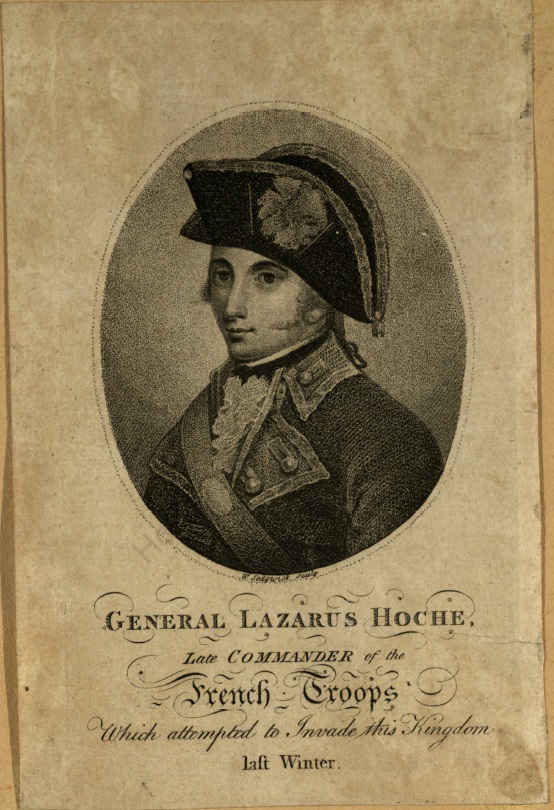
March 2020
This month the Oireachtas Library is exhibiting a 1797 print of General Lazare Hoche. Hoche was the commander of an attempted French invasion of Ireland in December 1796.
The newly formed French Republic believed that Ireland would be an ideal place from which to launch an invasion of England. Several members of the revolutionary Society of United Irishmen, including Theobald Wolfe Tone, travelled to France to assure leaders that hundreds of thousands of Irish people would be willing to support them.
The experienced General Lazare Hoche was appointed to lead the expedition. Tone was granted a commission in the French army, and he was on board one of the ships that set sail from Brest in December 1796. Even though they mostly evaded British ships, appalling weather conditions quickly broke up the fleet, with several ships blown out into the Atlantic. For those that reached the Irish coast it proved impossible to land, despite Tone’s lament that they were “near enough to toss a ship’s biscuit ashore”. Several ships were lost, and what remained of the fleet returned home to Brest several weeks later.

Cartoon by caricaturist James Gillray inspired by the French military disaster
Hoche went on to success elsewhere in the French revolutionary wars before he suddenly fell ill and died in September 1797. It was on board the flagship Hoche that Tone returned with French forces in 1798 but this second invasion was defeated. Arrested, tried and found guilty of treason, Tone died by suicide before his execution was carried out.
The portrait of Hoche is one of a small collection of engravings and prints of 18th and 19th century personalities and politicians from the Oireachtas Library’s Dublin Castle Collection.
References
Bartlett, T. (2010). Ireland: a history. Cambridge: Cambridge University Press.
Tone, T. W., & O'Faoláin, S. (1937). The autobiography of Theobald Wolfe Tone. London ; New York: T. Nelson.
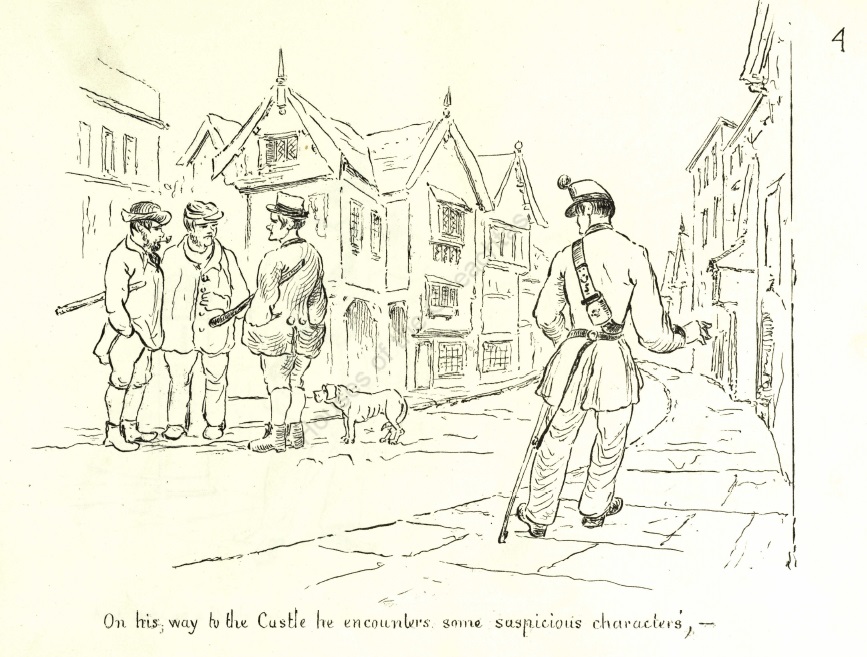
February 2020
This month the Oireachtas Library is exhibiting an unusual cartoon book about the unsuccessful Fenian plot to raid Chester Castle on 11 February 1867. The story depicts Ensign Smith as he reports for duty at Chester Castle, where he gets drunk, dreams about defeating the Fenians and then heads home to a family christening.
The plot to raid Chester Castle was spearheaded by John McCafferty, a fiery Irish-American who fought for the confederate army during the American Civil War. Under American leadership, Fenian members from all over the north of England were to meet in Chester on 11 February 1867. They would steal a lightly guarded cache of weapons and ammunition from the castle to smuggle back to Ireland for the planned rising in Dublin.
However, on the night of 10 February an informer alerted the Liverpool police, and the plan had to be called off. There wasn’t enough time to send word to everyone, and over 1,000 Fenians arrived in Chester in the early hours of 11 February, only to discard what few weapons they shared and retreat as quickly as possible.
Hundreds of soldiers were sent to Chester to bolster the castle’s defence, but there was little to do once they arrived. The whole event caused much amusement, with the Manchester Guardian joking that “the excitement seemed to be welcomed by many as an agreeable relief to the oppressive monotony of ordinary Chester life”.
This satirical book appears to have been created not long after the event, based on the date written on the cover.
The book has been digitised and can be read in full on the Oireachtas Library online catalogue.

References
Moody, T.W. (1981) Davitt and Irish revolution 1846-82. Clarendon Press, 1981
"Late Georgian and Victorian Chester 1762-1914: Politics, 1835-1914." A History of the County of Chester: Volume 5 Part 1, the City of Chester: General History and Topography. Eds. C P Lewis, and A T Thacker. Victoria County History, 2003


January 2020
This month the Oireachtas Library is marking 200 years since the publication of James Hardiman’s renowned history of Galway by exhibiting our first edition copy in the Leinster House display case.
“Many a single shire in England has been more copiously described and better illustrated than the whole of Ireland!”
Hardiman was born in Mayo but spent his childhood in Galway. He intended to go into the priesthood but was prevented by a serious injury to one of his eyes. He studied law in Dublin, became a solicitor and worked in the Public Record Office in Dublin. His passion for historical research led to the publication of his first book, The History of the Town and County of the Town of Galway, in 1820.

Title page of Hardiman's History of the Town and County of the Town of Galway
According to Hardiman’s preface, the book was intended to fill a gap in the historical record of Ireland. He believed that too little was known in Britain about Ireland, particularly the western part of the island. Containing facsimile maps and engravings, the book outlines the history of Galway from its beginnings to the post-Union period. It is still considered an important reference work today.
The fourteen ancient families or "tribes" of Galway
Hardiman was an active member of the Royal Irish Academy, and a fluent Irish speaker. He researched and wrote about Irish history, archaeology and culture. At one point he became involved with the peerage claim of James Netterville, conducting extensive research to help the distant cousin of an aristocratic family claim the title of Viscount. Hardiman had to sell some of his manuscripts to the British Museum at a reduced rate simply to fund the research, which was ultimately successful (though not financially rewarding). He was a founding member of the Celtic Society and the Irish Archaeological Society, and became librarian at Queen’s College of Galway when it opened in 1849. The James Hardiman Library at NUIG is named after him.
Reference
O'Brien, A. & Lunney, L. (2012). Hardiman, James. In McGuire, J & Quinn, J. (ed.), Dictionary of Irish Biography. Cambridge, United Kingdom: Cambridge University Press
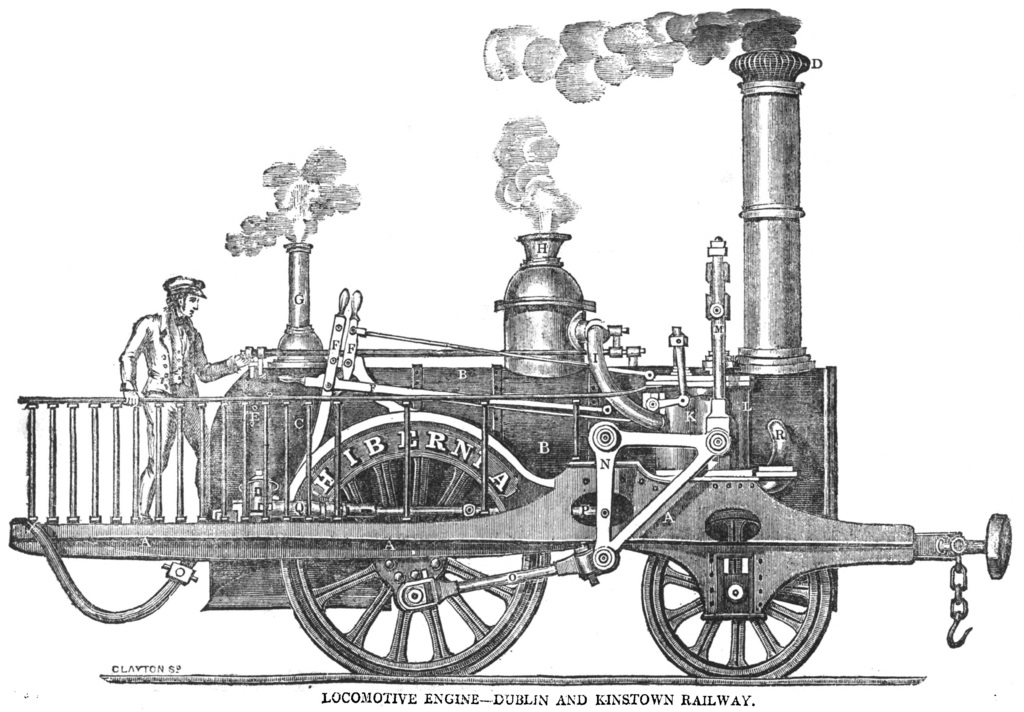
December 2019
This month the Oireachtas Library is marking 185 years since the first passenger railway in Ireland – the Dublin and Kingstown Railway - by displaying a pamphlet by James Pim, Jr., a key figure behind the railway’s development. Addressing Member of Parliament Frederick Shaw, Pim discusses the challenges and opportunities of implementing a national railway in Ireland.
Though a stockbroker and businessman, he believed that the state should be involved in planning and developing the railway, not just for profit but as a means of promoting industrial growth in Ireland. He describes the issue as “one of the most important, if not the most important Irish practical question that has ever been discussed within the walls of Parliament”.

Pim was born to an enterprising Quaker family in Dublin. He became passionate about developing an Irish railway following the development of the first inter-city railway in the world between Liverpool and Manchester in the late 1820s. Forming the Dublin & Kingstown Railway Company with other Dublin businessmen he pushed for a parliamentary act to establish a railway in Dublin, which was passed in 1831.
The design and construction of the line from Westland Row to Dunleary (later extended to Kingstown) was led by renowned engineer William Dargan. On the morning of 17 December 1834, the first train departed from Westland Row. By the end of the day almost 5,000 passengers had travelled aboard. It was intended, like many early railways, to support the transfer of freight, but quickly became established as the first suburban passenger railway in the United Kingdom.

References
Jones, S.P. (2009). Pim, James. In McGuire, J. & Quinn, J. (ed.), Dictionary of Irish Biography. Cambridge, United Kingdom: Cambridge University Press.
Murray, K., & Irish Railway Record Society. (1981). Ireland's first railway. Dublin: Irish Railway Record Society.
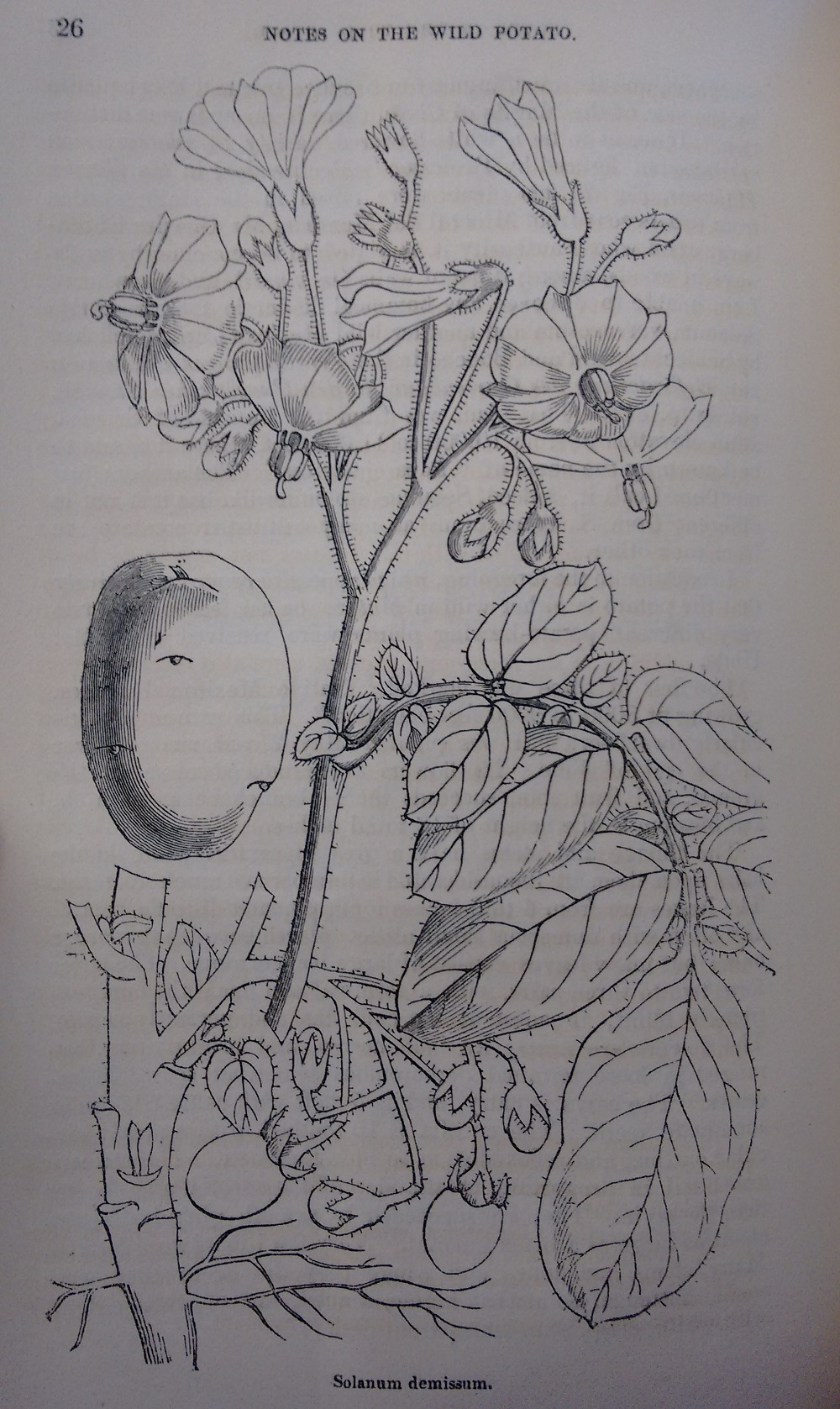
November 2019
This month the Oireachtas Library is marking Science Week by displaying Robert Thompson’s 1847 report on experiments to cure the blight that had been destroying potato crops throughout America and Northern Europe. The effect had been devastating in Ireland, where the majority of the population was reliant on the potato as the main source of food.
Thompson, a superintendent at the Horticultural Society in London, planted tubers and experimented by scattering over different combinations of lime, charcoal, salt, sulphates, potash and chalk. He planted tubers alternated with bean plants and in the shade of Indian corn and also planted rows to which nothing was applied, as a control.
In the second part of the report John Lindley, a prominent botanist, explores the theory that procuring potatoes from their "native country" might help to eradicate the disease. Once the blight reached England Lindley had recognised the potential dangers for Ireland, and he was part of the commission first sent there in late 1845 to investigate the effects. At the end of this 1847 report he ominously concludes that his and Thompson’s work demonstrated that the disease could not be prevented, and that not a single recommendation could be made to the public to thwart the spread of the blight.
When the potato blight first emerged in Ireland, there was some wild speculation as to potential causes, including fairies, lightning or a curse brought about by Catholic emancipation. Two theories came to dominate scientific thought – that the blight was caused by a fungus, and that it was caused by excessive moisture from heavy rainfall.
 John Lindley
John Lindley
The meteorological cause, of which botanist John Lindley was a proponent, became the prominent theory for some years until further investigation showed that while wet and windy conditions aided the spread of the disease it was essentially a fungus. In 1882 French botany professor Pierre Marie Alexis Millardet accidentally discovered how to make a successful fungicide for grape vines. That same mixture of copper sulphate and lime was found to work well in controlling potato blight and is still used today.
References
O’Neill, T.P. (1946) The Scientific Investigation of the Failure of the Potato Crop in Ireland, 1845-6. Irish Historical Studies, 5 (18), pp. 123-138.
Bourke, P.M.A. (1964) Emergence of Potato Blight, 1843-46. Nature, 4947, pp. 805-808.
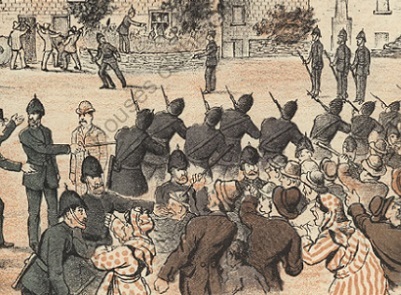
October 2019
This month the Oireachtas Library is marking 140 years since the foundation of the Irish National Land League by displaying a cartoon showing an attempted eviction at Castleview, Co. Cork in 1886. The cartoon was included as a supplement in United Ireland, the nationalist weekly newspaper.
The late 1870s in Ireland saw poor weather and harvests that greatly affected small tenant farmers.
Unable to pay rising rents to their landlords, many tenants were evicted. In response, a number of tenants’ rights organisations were founded, including the Mayo Land League under activist and Republican Michael Davitt. At the same time, Charles Stewart Parnell, then a prominent member of the Home Rule Party, became convinced that alliance with the land reform movement would be valuable in his political campaign for Irish independence.

On 21 October 1879 the Irish National Land League was established, with Parnell as its president. The League wanted fair rents and the transfer of land ownership to Irish tenants. The League was at the forefront of the ‘Land War’ that followed from 1879 to 1882. When it was suppressed in 1882, the Irish National League became its successor, and the Land War was renewed when evictions rose again in the mid-1880s.
The Irish land issue consumed British politics in the 1880s. Large groups often gathered at evictions, and there was great media interest in these events. The cartoon here depicts the efforts of the Royal Irish Constabulary to remove Timothy Hurley from his house and mill.
According to a newspaper report, “the tenant came to the window and said he was willing to pay a fair rent, but he could get no fair play from his landlord, and he was now prepared to defend his home or die”. Hurley and a group of supporters barricaded themselves into the building, throwing stones, timber and boiling water at the approaching policemen. The scene in the lower right corner shows a large crowd of League members carrying a hut to the site, so that Hurley would have somewhere to spend the night. However, the eviction was eventually abandoned.
Further reading
McLachlan, N. (2009). Davitt, Michael. In J. McGuire, & J. Quinn (Ed.) Dictionary of Irish Biography. Cambridge: Cambridge University Press
Moody, T.W. (1981). Davitt and Irish revolution, 1846-82. Oxford: Clarendon Press
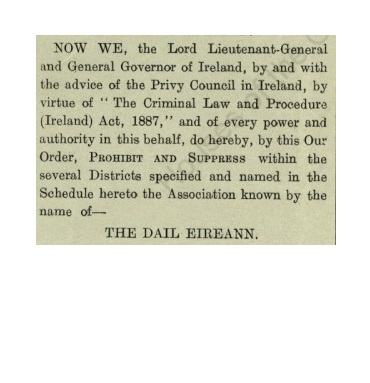
September 2019
This month the Oireachtas Library is exhibiting a supplement to the Dublin Gazette from 11 September 1919, containing the Lord Lieutenant and Privy Council’s proclamation that “The Dáil Éireann” was considered a dangerous organisation and was now prohibited.
Since 1918 the government had been attempting to suppress the growing push for independence in Ireland by targeting nationalist organisations in a number of specified counties, including Sinn Féin, the Sinn Féin clubs, the Irish Volunteers, Cumann na mBan and the Gaelic League.
A proclamation published in the Dublin Gazette in November 1919 finally outlawed these groups on a nationwide basis.
The actions were taken under the Criminal Law and Procedure (Ireland) Act 1887, which had been introduced by the Chief Secretary for Ireland Arthur Balfour to suppress Parnell’s Irish National League and deal with agrarian protests during the Land War. The Lord Lieutenant was granted powers to outlaw dangerous organisations and hold special jury trials. From the end of 1918, as the nationalist conflict escalated in Ireland, hundreds of cases were dealt with under the Act, with over 1,000 people prosecuted.

The Library is also exhibiting a news article from the end of November 1919 reporting on the final proclamation by the Lord Lieutenant. It also reports that both the Sinn Féin and Dáil Éireann offices on Harcourt Street had been raided “again” by soldiers, uniformed police and detectives. The article mentions that a large crowd gathered outside during the raids “displayed considerable hostility towards the police and military”. It is notable from the list of outlawed organisations in 1919 that the government did not distinguish between military, political and cultural nationalist groups, a decision which only served to increase support for republicans as the conflict wore on.
Visit the Dáil100 website to read a vivid eyewitness account of a raid on the Dáil and Sinn Féin offices and find out more about the suppression of the First Dáil.

Portrait of Queen Victoria by Alexander Melville, 1845
August 2019
This month the Oireachtas Library is marking the 170th anniversary of Queen Victoria’s first visit to Ireland by displaying a celebratory poem by John D’Alton. This unpublished poem was printed and submitted to the Irish Office in London by D’Alton himself and is now part of the historical collection at the Oireachtas Library.
Victoria brought Prince Albert and four of her children with her on her first visit to Ireland. The royal yacht arrived in Cobh (then Cove) on 2 August 1849 to an enthusiastic reception. The town was renamed Queenstown in her honour.
She knighted the Mayor of Cork and toured Cork city, declaring later in her diary that “Cork is not at all like an English town. It looks rather foreign. The crowd is a noisy, excitable, but a very good-natured one, running and pushing about, talking and shrieking”. Victoria then continued to Dublin, and finally Belfast, before departing for Scotland on 12 August.

Queen Victoria’s procession on Grand Parade, Cork / Courtesy of Cork City Libraries
D'Alton’s gushing poem was representative of the general warmth with which Victoria was received. Though the sentiments were by no means universal, the welcome was still something of a surprise coming so soon after the emergence of a devastating famine, and only one year after the armed rising of the Young Irelanders. However, it may be that the pomp and ceremony was a welcome distraction to city crowds. The royal party did not visit the countryside, where the worst effects of the famine were visible. Irish nationalism was also in a disorganised state. Daniel O’Connell’s mass movement to repeal the 1801 Act of Union had dissipated, and the attempted insurrection by the Young Irelanders in 1848 had been an embarrassing failure.
Though the visit was a success, it did not lead to any fundamental change in political relations between Ireland and Queen Victoria. She visited again in 1853 and 1861, but her coolness towards the country only increased with the rise of land agitation and the Irish Parliamentary Party, as well as the spread of Fenian violence. By the time of her last visit in 1900 there was much more open criticism from members of the political and cultural Irish nationalist movement, for whom she would always be the "famine queen".
Read the full poem in the Oireachtas Library catalogue
References
Loughlin, J. (2002) Allegiance and Illusion: Queen Victoria’s Irish Visit of 1849. History, 87 (288), pp. 491-513.
Johnson, J.D.A. (1933) Queen Victoria’s visit to Cork. Journal of the Cork Historical and Archaeological Society, 38 (148), pp. 103-107.
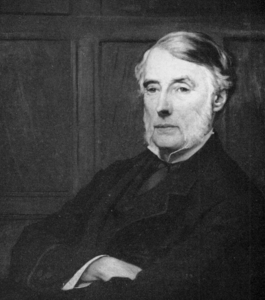
James Hack Tuke, 1819-1896
July 2019
This month the Oireachtas Library is displaying the 1883 report of the Tuke committee. This year marks the 200th anniversary of the birth of James Hack Tuke, an English Quaker remembered for his philanthropic work in the west of Ireland during the 1880s.
In the late 1870s a combination of bad weather, failed harvests and competition from cheap imports meant that Irish tenant farmers were suffering badly. By 1879 a famine situation had arisen.
Authorities were quicker to intervene than they had been in the 1840s, but struggled to improve the situation in the congested districts of Connacht, where the land was poorer and the holdings very small.
In 1880 James Hack Tuke visited the region and concluded that economic rather than political intervention (as prioritised by the Land League and Irish Parliamentary Party) was what was required to alleviate the situation. Amongst several recommendations he called for a scheme of assisted emigration to the US and Canada, and formed a private committee to raise funds and administer the process.
In order to ensure success Tuke’s committee focused on a number of principles: Emigrants should be whole families rather than individual people, so as best to ease congestion on the land and free up entire holdings that could be taken by neighbouring tenants. No pressure should be put on anyone to emigrate. Families would be provided with new clothes and subsistence money, and should be booked through to a final destination. A majority of the family members emigrating needed to be of bread-winning age (i.e. over 12). The committee made all the travel arrangements, including transport for families to the boats. They even prioritised sailings earlier in the year so that people had time to settle in before the winter.

Irish emigrants just arrived in New York / Library of Congress
Applications soared, and Tuke mentions in his report how difficult it was to turn away desperate families who weren’t suitable for the scheme. The success prompted the government to make additional money available through the 1882 Arrears of Rent Act and the 1883 Tramways and Public Companies Act. Some of this went to Tuke’s committee, with the rest used by the boards of guardians in the poor law unions to administer their own assisted emigration programme.
Though by no means solving the problems in the west of Ireland, Tuke’s private scheme assisted over 9,000 people to start a new life in North America. He continued working to alleviate poverty and hunger in Ireland, and his reports on conditions in the west and northwest were influential in the establishment of the Congested Districts Board in 1891. He died in 1896.
References
Moran, G. (1995) Escape from hunger: the trials and tribulations of the Irish state-aided emigrants in North America in the 1880s. Studia Hibernica, 29, pp. 99-115.
Moran G. (2013) James Hack Tuke and his schemes for assisted emigration from the west of Ireland. History Ireland, 21 (3). Retrieved from https://www.historyireland.com/18th-19th-century-history/james-hack-tuke-and-his-schemes-for-assisted-emigration-from-the-west-of-ireland/

June 2019
This month, to mark Bloomsday, the Oireachtas Library is taking a closer look at censorship in Ireland by exhibiting the Report of the Committee on Evil Literature from 1926. James Joyce’s novel Ulysses, now celebrated in an annual festival on 16 June, caused uproar when it was first published. Deemed obscene by many, the book was banned in the United States and Britain, with hundreds of copies burned.
Though it was never formally banned in Ireland it was prevented from being imported, which ensured censorship of its content for decades.

When the Irish Free State was established in 1922, Roman Catholicism – the religion of the majority of the population – was generally accepted as a vital means of delineating between British and Irish identity. Roman Catholic Church morals, therefore, were very much reflected in the policies of the new Free State Government.
It was against this backdrop that a small group of Roman Catholic activists campaigned for the censorship of "demoralising" books and newspapers, with a focus on non-Irish publications. They were worried about the corrupting influence of lurid court case details (including “divorce cases”) in British newspapers, and imported pamphlets with information about birth control. Their lobbying led Justice Minister Kevin O’Higgins to establish a committee in 1926 “to consider and report whether it is necessary or advisable in the interest of public morality to extend the existing powers of the State to prohibit or restrict the sale and circulation of printed matter”.

Minister for Justice, Kevin O'Higgins
Witnesses to the committee included members of religious interest groups and representatives from the postal service, the police force and retailers, including Mr. Charles Eason. The report indicated a majority level of support for new legislation, with a focus on preventing the import of offending material. The committee noted the difficulty of censoring books but recommended that a censorship committee be set up regardless, to review publications: “It ought not to be difficult for a group of citizens selected for their culture, good sense and respect for morality to recognise books written with a corrupt intent”.
The committee’s work led to the drafting of a Censorship of Publications Bill, enacted in 1929. Out of this a Censorship of Publications Board was established to review publications and it is still in existence to this day.
References
Horgan, J. (1995) Saving us from ourselves: contraception, censorship and the ‘evil literature’ controversy of 1916, Irish Communication Review, 5 (1), pp. 61-67.
Keating, A. (2013) Censorship: the cornerstone of Catholic Ireland, Journal of Church and State, 57 (2), pp. 289-309.
Bradshaw, D. (2016) Ulysses and obscenity, British Library. Available at: https://www.bl.uk/20th-century-literature/articles/ulysses-and-obscenity
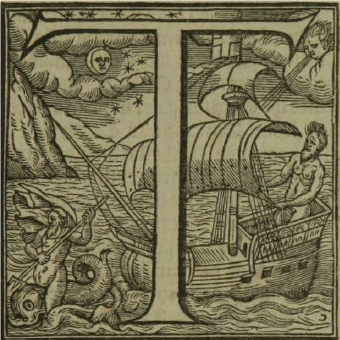
May 2019
Holinshed’s Chronicles of England, Scotland and Ireland
This month the Oireachtas Library is highlighting one of the oldest books in our collection, Holinshed’s Chronicles of England, Scotland and Ireland. The Library’s copy is the second edition, published in 1587, and was originally part of the library of the Chief Secretary at Dublin Castle.

The Chronicles originated from an ambitious attempt by the Dutch-born, London-based printer Reyner Wolfe to publish a history of the world. He died before the book could be finished, and so his assistant, Raphael Holinshed, took up the project, but decided to limit the scope to just Britain and Ireland. The first edition was published in 1577, illustrated by woodcuts. Ten years later an expanded edition was published. This had no woodcut illustrations but did contain highly decorated front pages for each volume and decorated letters at the beginning of many chapters.

Though named after Raphael Holinshed the book was actually a major collaboration between about eight writers and a number of printers and publishers. The original passages on Ireland were compiled by Richard Stanihurst, a scholar, diplomat, writer and alchemist from Dublin, who based much of his work on a history compiled by his mentor Edmund Campion. The section on Ireland was updated in 1587 by the English writer and civic administrator John Hooker.
Though the histories contained in Holinshed’s Chronicles were not always entirely reliable the 1587 edition is particularly famous because it was used by William Shakespeare as a source for more than one third of his plays, including Macbeth, King Lear and the history plays. Other writers of the Elizabethan era, including Marlowe and Spenser, were also inspired by stories in Holinshed’s Chronicles.
References
Colm Lennon (2009). Stanihurst, Richard in James McGuire, James Quinn (ed.), Dictionary of Irish Biography. Cambridge, United Kingdom: Cambridge University Press.
The Holinshed Project. http://www.cems.ox.ac.uk/holinshed/index.shtml
Holinshed’s Chronicles, 1577. British Library. https://www.bl.uk/collection-items/holinsheds-chronicles-1577
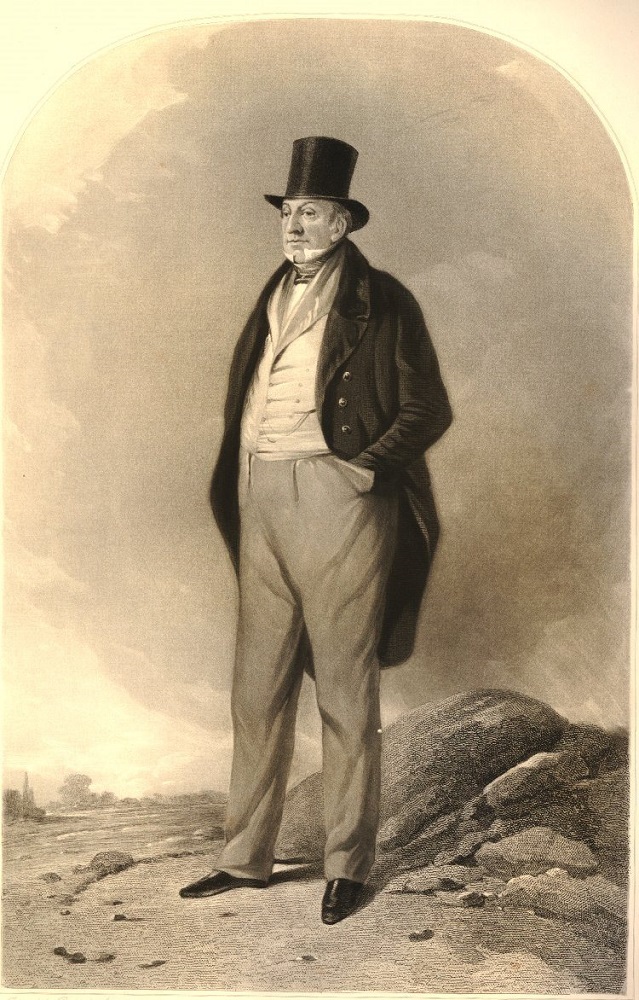
Charles Talbot, Lord Lieutenant of Ireland
April 2019
First report of the General Board of Health 1822
This month, to mark World Health Day on 7 April, the Oireachtas Library is displaying the First Report of the General Board of Health in Ireland in 1822. This report comes from the historical Dublin Castle Collection.
The second half of the 1810s had been marked by a severe period of famine and disease.
In 1815, an enormous eruption of Mount Tambora in the Dutch East Indies (now Indonesia) sent so much ash into the atmosphere that the earth cooled. This led to a devastating subsistence crisis around the world. In Ireland, persistent cold and rain led to failed crops and wet turf. A typhus epidemic followed between 1817 and 1819, killing tens of thousands. In response to these events the Lord Lieutenant of Ireland, Charles Talbot, established a permanent, centralised General Board of Health in 1820.


Charles Talbot, Lord Lieutenant of Ireland 1817-1822 and the First report of the General Board of Health
Fever hospitals and dispensaries had been on the increase throughout Ireland and fever outbreaks often led to temporary, locally established committees. But up to this point there had been no attempts to centralise administration of public healthcare. The Board was tasked with inquiring into the state of public health around the country and investigating ways to improve it. It began by issuing a survey to Irish and Anglo-Irish landowners, clergymen, magistrates and doctors in each county. The survey posed questions about the health conditions of the poor in each area, the state of their dwellings, their supply of fuel, clothing, food and employment. Because the Board received so many replies they decided to concentrate on Munster for the first report, which was presented to the new Lord Lieutenant in 1822.
The collated results of the survey paint a picture of pervasive scarcity throughout the counties of Munster. In Clonmel “the condition of the poor as to bedding is wretched; they sleep on straw, seldom changes, and frequently on the damp ground”. In Clare, at Newmarket on Fergus “numbers are reported to be half-naked and half-starved from deficiency of employment”.
Though the responses are mostly sympathetic, demonstrating the increasing recognition of the link between poverty and poor health, they are interspersed with occasional moral judgements. One respondent complained that Irish women were not keeping their cabins clean enough, and that “nothing is more difficult than to induce the common Irish to allow proper ventilation in their houses”.

The Board’s design for an improved Irish cottage
The report concludes with several recommendations for the improvement of health, such as the publication of a pamphlet to encourage uptake of the smallpox vaccine, of which the poorer classes remained suspicious. The Board also printed designs for elevated cottages to alleviate damp and improve ventilation, as well as designs for temporary fever hospitals. Though the General Board of Health operated mainly as an advisory body in the following years, its establishment – almost twenty years before its equivalent in England – marked a significant increase in public health intervention by governments.
References
Geary, L. M. (2018) From voluntary hospitals to voluntary health insurance: a history of Irish healthcare from the early-eighteenth to the mid-twentieth century. In The Irish Healthcare System: an historical and comparative review. Dublin, Healthcare Insurance Authority, pp.9-27
Maye, B. (2016) A volcanic eruption with global repercussions: An Irishman’s Diary on 1816, the year without a summer. The Irish Times, 16 August. Retrieved from: https://www.irishtimes.com/opinion/a-volcanic-eruption-with-global-repercussions-an-irishman-s-diary-on-1816-the-year-without-a-summer-1.2760797
Ó Gráda, C. (1995) Ireland: a new economic history 1780-1939. Oxford, Oxford University Press.
O’Neill, T.P. (1973) Fever and public health in pre-famine Ireland. The Journal of the Royal Society of Antiquaries of Ireland, 103, pp.1-34. Retrieved from: http://www.jstor.org/stable/25508612
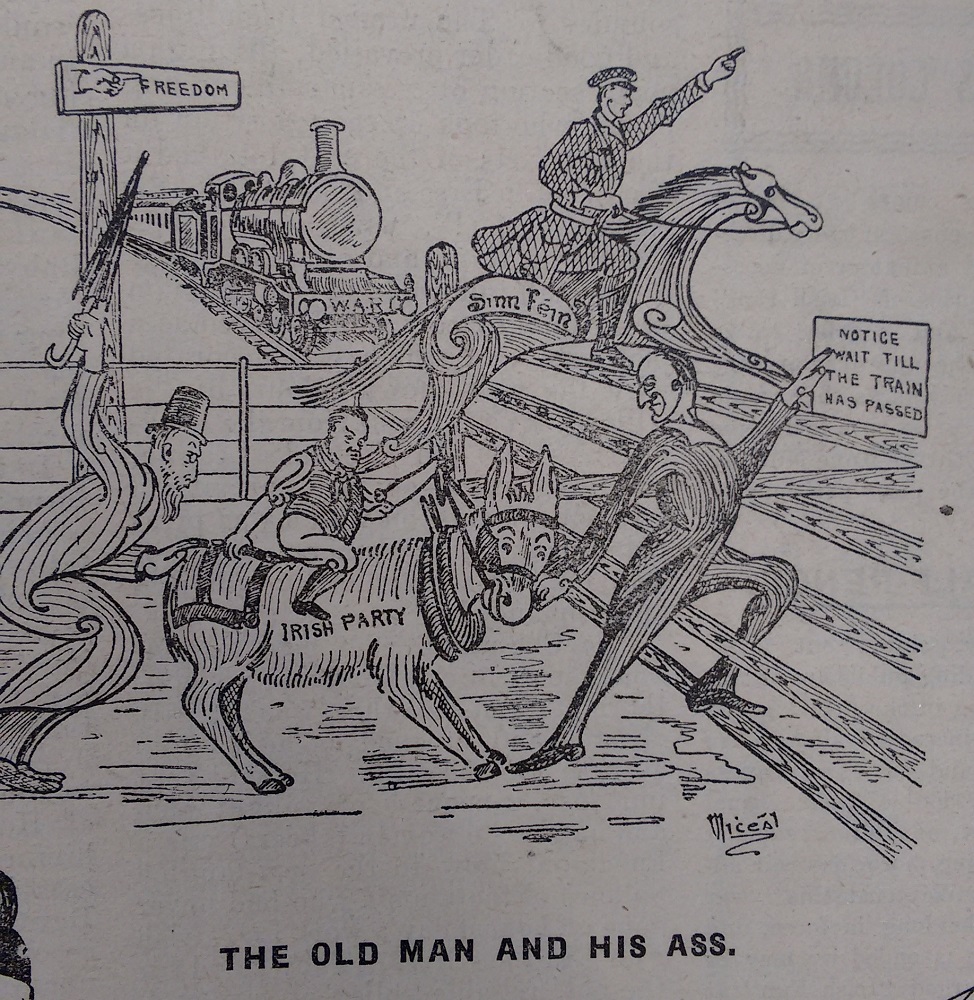
Irish Fun cartoon, May 1918
March 2019
This month the Oireachtas Library is looking at the legacy of the Irish Parliamentary Party by displaying political cartoons from two issues of the periodical Irish Fun: A Tonic in Type.
Dating from October 1917 and May 1918, these cartoons mock the Irish Parliamentary Party (IPP), which had been in marked political decline since 1916 and was the object of much satire for Sinn Féin periodicals like Irish Fun.
The IPP had been the main political driver of Irish nationalism for decades, advocating for a self-governing Irish parliament within the United Kingdom. In 1914, it looked like home rule was finally going to become reality but it was put on hold at the outbreak of the war. In the years that followed the IPP suffered a complete collapse in popularity. By the time an election was held in December 1918, the party returned only six seats in Ireland to Sinn Féin’s 73, a crushing defeat.

Irish Fun cartoon, October 1917
Unlike Sinn Féin, the IPP took up their seats in Westminster, where they continued to represent Irish nationalist interests under the leadership of Joseph Devlin. They criticised the British government’s policy towards Ireland throughout 1919 and 1920. After Bloody Sunday on 21 November 1920 Devlin was physically attacked by another MP in the chamber for raising questions about the reported military killing of civilians in Croke Park. The party was very conscious of their perception as pro-British. They agreed not to compete with Sinn Féin for seats in the 1921 election in southern Ireland. That meant that none of their members were elected to the second Dáil (or House of Commons of Southern Ireland), members of which negotiated and debated the Treaty.

Joseph Devlin, Leader of the IPP (1918-21)
In the north, Joseph Devlin and other former IPP members formed the Nationalist Party. They co-operated with Sinn Féin so that both parties returned six seats each to the House of Commons of Northern Ireland in the 1921 elections. They pursued a mostly abstentionist policy in the decades that followed.
In the south, prominent IPP member Stephen Gwynn had founded the Irish Centre Party in 1919 in an attempt to reinvigorate the debate for home rule in Ireland. With little support from either nationalists or unionists, however, Gwynn merged the party with Sir Horace Plunkett’s Irish Dominion League. This also advocated a form of home rule but the party only lasted until 1921.
Some former IPP members ran for the Dáil as independents, including Alfie Byrne, the famous Dublin lord mayor. Captain William Redmond, the son of John Redmond, founded the National League Party with Thomas O’Donnell in 1926, but lost support after a failed attempt in 1927 to oust Cumann na nGaedhael in favour of a Labour/Fianna Fáil coalition. Others joined Cumann na nGaedhael and the National Centre Party, both of which amalgamated into Fine Gael in 1933. Thomas O’Donnell was one of the few prominent former IPP members to join Fianna Fáil.

Irish Fun is part of a small collection of early 20th century newspapers and magazines in the Oireachtas Library’s Special Collections.
References
HC Deb 22 November 1920, vol 135, cols 38-43. Accessed 21/02/2019 at: https://api.parliament.uk/historic-hansard/commons/1920/nov/22/murder-conspiracy
Dorney, J. and O’Donoghue, M. (2017). The Irish Parliamentary Party after 1918, an interview with Martin O’Donoghue. Accessed 21/02/2019 at: http://www.theirishstory.com/2017/01/21/the-irish-parliamentary-party-after-1918-an-interview-with-martin-odonoghue/#.XFrU1_43aUl
Michael L. (2009). Redmond, John Edward. In J. McGuire, J. Quinn (eds.), Dictionary of Irish Biography. Cambridge, United Kingdom: Cambridge University Press. Accessed 21/02/2019 at: http://dib.cambridge.org/viewReadPage.do?articleId=a7602)
O’Donovan, J. (2015). The Decline of Irish Parliamentary Party. Accessed 21/02/2019 at: http://theirishrevolution.ie/decline-irish-parliamentary-party/#.XFrSiP43aUk
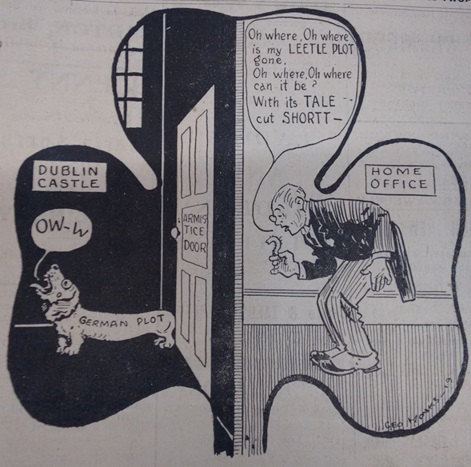
February 2019
This month the Oireachtas Library is remembering Eamon de Valera’s escape from Lincoln jail by exhibiting a copy of The Shamrock magazine from February 1919. The satirical cartoon on the cover shows the Home Secretary, Edward Shortt, searching for his "German Plot", which is depicted as a dog with its “TALE cut SHORTT”.
The German Plot was a political conspiracy that took place in May 1918 while Shortt was Chief Secretary for Ireland. The Dublin Castle administration accused Sinn Féin of engaging in "treasonable communication with Germany" and the party’s leaders were subsequently rounded up and interned in English prisons.

By the time this issue of The Shamrock was published in mid-February 1919, de Valera had escaped from Lincoln jail along with Seán Milroy and Seán McGarry, bringing the number of escapees to seven. There was mounting pressure on and from within the newly elected British government to release the other Sinn Féin prisoners. In early March the Cabinet finally acquiesced to a gradual release of the remaining internees.
The issue also contains short stories, poems, cultural reviews and commentary on nationalist issues, with decorative headings for each section.


There is even a humorous page dedicated to the “press cuttings of tomorrow”, in which a news article from the year 2000 reports that a federation of Celtic people has organised all over Europe, and that “all means of aerial transport is in the hands of the Gael, who has by this means forced all the world to learn his almost impossible language”.
The Shamrock is part of a small collection of early 20th century newspapers and magazines in the Oireachtas Library & Research Service Special Collections.
Further reading
McCullagh, D. (2017) De Valera : Rise 1882-1932. Dublin: Gill Books.
De Valera in sensational escape from Lincoln Prison, RTÉ Century Ireland: https://www.rte.ie/centuryireland/index.php/articles/de-valera-in-sensational-escape-from-lincoln-jail
Learn more about the centenary of Dáil Éireann at www.dail100.ie

Arthur Griffith / Courtesy of the National Library of Ireland
December 2018
This month the Parliamentary Library is displaying a copy of Arthur Griffith’s pamphlet entitled The Resurrection of Hungary: A Parallel for Ireland, which was published in 1904. According to the historian Brian Maye, Griffith was struck by the parallel he saw between Hungary and Ireland – two small countries linked with great empires. He believed that the history of Hungary contained an important lesson for the Ireland of his own time.
This led him to call on Irish MPs, in October 1902, to end their attendance at Westminster and set up their own parliament in Dublin.

He outlined his policy in a series of 27 articles in the United Irishman newspaper. In November 1904 the articles were published in pamphlet form and more than 20,000 copies were sold within three months of publication.
The policy suggested that Ireland should become a separate kingdom alongside Great Britain, the two forming a dual monarchy with a shared monarch but separate governments. Griffith thought that this solution would be more palatable to the British. With the founding of Sinn Féin in 1905 Griffith first presented this theory as the "Sinn Féin policy". However by 1916 dual monarchism as a policy was replaced by republicanism.

Arthur Griffith / Courtesy of the National Library of Ireland
Griffith was one of 73 members of Sinn Féin arrested in May 1918 on the pretext that they had conspired with Germany (the so-called German Plot). He spent the period on the run-up to the 1918 general election in prison but was elected for both the Cavan East and Tyrone North-West constituencies. He was one of the Members described as “fé ghlas ag Gallaibh” (imprisoned by a foreign enemy) during the roll call at the first meeting of Dáil Éireann on 21 January 1919.
Griffith never aspired to leadership of a political party, preferring to remain as a policy maker and adviser. According to Seán Ó Lúing:
“his mature and realistic mind was a valuable stabilizing factor in the First Dáil, which, like its successor, was composed of extreme and militant nationalists. Dáil Eireann itself was designed out of the thought of many years which Griffith had given to national planning, and it, and its institutions, provided the moral and democratic structure that sustained the later years of Irish revolution”.
References and further reading
McGee, O. (2015). Arthur Griffith. Dublin, Merrion Press.
Ó Lúing, S. (1971). Arthur Griffith, 1871-1922: Thoughts on a Centenary. Studies: An Irish Quarterly Review, Vol. 60, No. 238, pp. 127-138.

Supreme Allied commander Ferdinand Foch and military representatives after signing the Armistice on 11 November 1918
November 2018
This month the Parliamentary Library is marking the 100th anniversary of the end of the First World War by exhibiting the first interim report of the Committee on the Interpretation of the Term “Period of the War”. This is from the Dublin Castle collection, which was transferred to the Library in the 1920s from the Chief Secretary’s office. The committee had been established by the Ministry of Reconstruction, which itself was tasked with planning for the end of the war.
A number of committees were set up by the Ministry to investigate housing, employment, health, education and other requirements for the post-War country, particularly for millions of demobilised military personnel.
Under the committee’s terms of reference, they would inquire into any legal questions arising from the determined date of the end of the war. In particular they needed to examine how any Acts, orders and regulations created during the conflict would be affected. For the committee, “the operation of the emergency statutes and orders is so far-reaching, the powers given are so vast, the responsibility of those exercising them so serious, that it would be a calamity if there were any real doubt as to when the respective rights and duties came to an end”.
The starting point for the committee, as laid out in this short interim report of January 1918, was to compile all the phrases used in wartime legislation to describe the period of the war.

They concluded that, as they expected the war to be ended formally by a treaty or treaties, the legal date of the end of the war could be taken as the date when ratifications were exchanged. By the time the Armistice was signed on 11 November 1918, the "Great War" had claimed approximately 40 million military and civilian casualties, half of whom had died from battle, famine or disease. At least 200,000 Irish men had served in the military (the vast majority of whom were volunteers) and approximately 35,000 Irish people were killed.
References
Dungan, M. (1997) Irish Soldiers and the Great War. Dublin: Four Courts Press.
Imperial War Museum https://www.iwm.org.uk/history/irelands-role-in-the-first-world-war
BBC http://www.bbc.co.uk/history/british/britain_wwone/ireland_wwone_01.shtml
October 2018
This month the Oireachtas Library is marking Budget 2019 by displaying a file of material relating to budgets, estimates and expenditures made between 1923 and 1924. The file is from the Oireachtas archival material collection held by the Oireachtas Library & Research Service.
The file displays a note from the then Ceann Comhairle, Michael Hayes TD, on the procedure to be followed in dealing with budget resolutions and the Finance Bill.
The budget for 1923 was discussed in the Dáil on 13 April 1923. The debate was introduced by the Ceann Comhairle and, because it was the first occasion upon which a Budget statement was about to be made, he reminded Members of the procedure to be followed. The Budget was then introduced by William T. Cosgrave TD, President of the Executive* and Minister for Finance.
In his overview of the Irish economy President Cosgrave said that:
“the general state of our finances makes it plain that reduction of taxation is out of the question at the present moment. Largely because of the campaign of destruction which has been waged in the country during the past year, borrowing to a great extent will be necessary during the current financial year. The credit of the State, and the conditions on which borrowing on such a scale will be found feasible, are matters on which it is not yet possible to frame definite conclusions, and it is, therefore, important that we should not depend more than we can help upon having resort to borrowing”.
Cabinet c.1923; W.T. Cosgrave centre front row / Courtesy of the National Library of Ireland
The budget introduced no new taxes and didn’t make any changes to existing taxes. The estimated deficit for the upcoming year was over £20 million as highlighted in the Freemans Journal of 14 April, 1923:
This budget was introduced just as the Civil War was ending. The war’s effect on the economy imposed a major burden on the new government. It has been estimated that the material damage involved amounted to more than £30 million and that it cost £17 million to finance the war. Ronan Fanning has written that “in 1923-24 30% of all national expenditure was devoted to defence and a further 7% to compensation for property losses and personal injuries”.
In concluding his speech, President Cosgrave remarked that:
“the anticipated deficit for the coming year is, no doubt, serious, but it is not such as to cause any misgiving as to the financial future of the Free State and the credit of the country. A large amount of the expenditure is non-recurring, and it is quite clear that on the arrival of settled conditions the revenue of the country will be ample to cover all commitments.”
The file on display also includes a copy of the Appropriation Bill 1923; Estimates for Public Services; Finance Bill 1923; Central Fund (No 1) Bill 1923; Supplementary Estimates to "defray the expenses" of public works and buildings, railways, public education, the army, post office and "to pay the expenses" of Seanad Éireann and the Ministry of Industry and Commerce.
References
Fanning, R. (1978) The Irish Department of Finance, 1922-58. Dublin: Institute of Public Administration.
Hopkinson, M. (1988) Green against green: the Irish Civil War. Dublin: Gill and Macmillan.
*From December 1922 until December 1937 the leader of the government was called the President of the Executive Council. Following the coming into operation of the Constitution of Ireland in December 1937 the title of the office became Taoiseach and the Office of President was established.
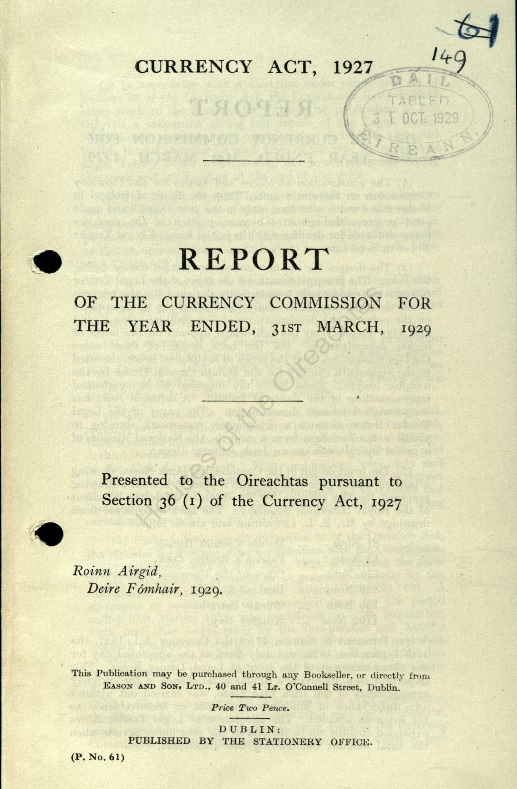
September 2018
This month the Oireachtas Library is marking 90 years since the first Irish state banknotes were entered into circulation. On display is the 1929 report of the Currency Commission, which had been established to oversee the production and issue of the new currency.
British notes and coins continued in circulation for several years after the foundation of the Free State. Irish trade and finance was linked extensively to the United Kingdom, and the emphasis on maintaining good ties and stability in the economy meant that the rollout of a national currency was not a particularly urgent priority for the new government.
Parliamentary debate about the issue began in earnest in the mid 1920s. The Coinage Act was passed in 1926, and a Banking Commission, chaired by Professor Henry Parker-Willis, an American finance expert, was set up to report on potential changes in the laws of banking and note issue for the new State. This recommended the establishment of the Free State’s own currency, of parity with sterling, and recommended setting up an independent Currency Commission to oversee the endeavour. The Currency Commission was formed after the passing of the Currency Act 1927 and was chaired by former Secretary to the Department of Finance, Joseph Brennan.
The document on display was the first report presented to the Oireachtas by the Commission after the new currency was issued. It records the progress made on distribution of the currency, and also describes the design choices for the legal tender notes. This included “an emblematic female figure” designed by Sir John Lavery (giving rise to the common reference to the "Lady Lavery banknotes"). On the reverse sides were a series of sculptured heads from the Dublin Custom House, to symbolise different rivers of Ireland.

Obverse side of a Series A £50 note, showing the female figure taken to be Lady Lavery, wife of artist Sir John Lavery

Reverse side of a Series A £50 note, showing the head designs based on Edward Smyth’s sculpture work on the Custom House
The legal tender notes were issued on 10 September 1928. Coins were issued in December of that year. The Currency Commission was eventually replaced by the Central Bank in 1942, and the Series A or "Lady Lavery" banknotes were in circulation until 1977. They were followed by Series B (1976-1992), Series C (1992-2000) and most recently the Euro currency.
Images
Images of Series A banknotes are kindly provided by Central Bank of Ireland Archives. An exhibition on the development of the independent state currency is now on display at the Central Bank Visitor Centre.
References
Kelly, J. (2003). The Irish Pound: From Origins to EMU. Central Bank Quarterly Bulletin, Spring, 89-115.
Honohan, P. (2002). Using Other People’s Money: Farewell to the Irish Pound. History Ireland, 10(1), 34-37.
Pratschke, J.L. (1969). The Establishing of the Irish Pound: a Backward Glance. Economic and Social Review, 1(1) 51-75.
Banking Commission (1926). First Interim Report on Banking and Currency. Accessible at http://opac.oireachtas.ie/AWData/Library3/Library2/DL068535.pdf
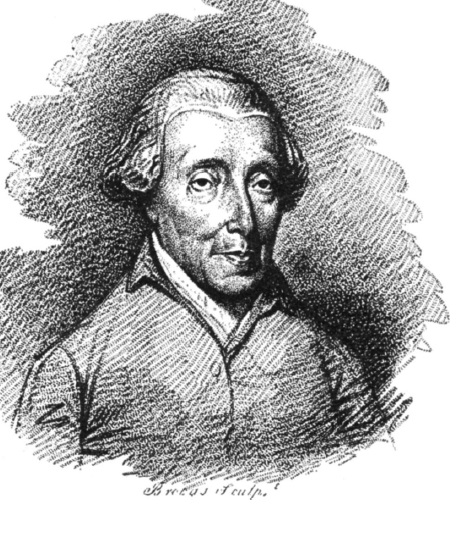
Richard Kirwan / From a drawing in Dublin Magazine December, 1812
August 2018
Given the recent atypical Irish weather, in August we took a look back at the early days of scientific weather observation in Ireland. We exhibited a copy of A Comparative View of Meteorological Observations Made in Ireland (circa 1793). This paper, which was read by Richard Kirwan at the Royal Irish Academy on 2 February 1793, is a daily record of the weather in Ireland during the years 1789 and 1790. It is included in a volume entitled Kirwan’s essays and sundries others and was acquired by the Houses of the Oireachtas Library in the 1920s.
During 1789 Kirwan noted that:
“from July the 1st to the 13th it rained every day in showers resembling thunder showers. But the 22nd it rained all day; on the 23rd a heavy shower … From this to August the 3rd it rained every second day. On the 7th, about sixty-four miles N. W. of Dublin, I met a violent storm with rain and some hail”.
Kirwan travelled outside Dublin too, and his observations for 1790 records that on:
“August the 1st, heavy rain in Galway. 3rd, 4th and 5th, dark and cloudy, but no rain; but from the 6th scarce a day passed without rain until the 24th”.
Kirwan kept a daily record of Dublin weather for many years. He observed the weather in the garden of his house in Cavendish Row. Others had kept weather diaries before him, but Kirwan’s observations were the first in Ireland to be compiled with the aid of accurate instruments. Records survive from 1787 to 1808, giving readings from a barometer, thermometers, a rain gauge, and an anemometer that he designed himself.
He was a prolific author of papers and books on chemistry, mineralogy, meteorology, and other subjects, and frequently published in the Transactions of the Royal Irish Academy. His books appeared in multiple editions in English, and four were translated into French, German, Spanish or Russian. His geological publications included the important books Elements of mineralogy (1784), which was the first English-language text on the subject, and Geological essays (1799).
Meteorologist and former Irish Times columnist Brendan McWilliams said that Kirwan:
“made a number of original contributions. Indeed many of his ideas anticipated 20th-century concepts: he evolved a theory of air masses, for example, and classified them 'polar', 'tropical' and 'marine' – ideas very familiar to today’s weather people. He also tried his hand at forecasting, using climatological information to predict the coming season, and the story goes that his predictions were so popular and well respected that farmers delayed their sowing until they knew the details of his latest prognostications”.

James Malton’s print of the Rotunda and Cavendish Row c. 1792 / National Library of Ireland
Further Reading: Met Éireann publications
Met Éireann’s Historical Note series has been in publication since 1995. It is issued on an irregular basis. Issues are compiled by Met Éireann staff and focus on the history of meteorology, with a particular emphasis on the history of meteorology in Ireland.
Their Major Weather Events series includes a report on the exceptionally fine and warm summer of 1798 when most of the fighting during the rebellion took place. The report notes that one effect of the fine weather on the course of the rebellion was to facilitate the Wexford rebels and their families who lived outdoors for several weeks and marched over long distances.
References
Burns, D.T. (2003). Richard Kirwan, 1733–1812: “the philosopher of Dublin”’, National Committee for the History and Philosophy of Science, 8th Annual Lecture, Royal Irish Academy.
Dixon, F. E. (1971). Richard Kirwan: the Dublin philosophe. Dublin Historical Record, 24, 52-64.
Donovan, M. (1847 – 1850). Biographical account of the late Richard Kirwan Esq. Proceedings of the Royal Irish Academy, 4, App. VIII, lxxxi-cxviii.
McWilliams, B (1988). A memorable eccentric, The Irish Times 23 June, page 2.
Treanor, M. (2012). A large area and a common plan: the progress of scientific meteorology in Ireland. Science at the Royal Irish Academy, 28-36, 404-408.
Wyse Jackson, P.N. (2009) Richard Kirwan. In McGuire, J; Quinn, J. (ed) Dictionary of Irish Biography. Cambridge, United Kingdom: Cambridge University Press.

Portrait of William Smith O’Brien / Artist unknown
July 2018
In August, to mark the 170th anniversary of the Young Irelander rebellion, we displayed the report of the trial of William Smith O’Brien. The report is one of several bound 19th century trial proceedings transferred to the Oireachtas Library in the 1920s from the Chief Secretary’s Office in Dublin Castle.
William Smith O’Brien was a descendant of Brian Boru, and an MP. He became a passionate advocate of repeal of the Act of Union in the House of Commons, joining Daniel O’Connell’s Repeal Association in 1843.
By the 1840s, something of a generation gap had emerged within the repeal movement. Younger repealers – well educated and broadly liberal intellectuals such as Charles Gavan Duffy and Thomas Francis Meagher – became impatient with the lack of political reform in Ireland. The situation was compounded by the onset of famine. In July 1846 this group of Young Irelanders, led by O’Brien, split from the Repeal Association because of O’Connell’s assertion that repeal should be achieved by non-violent means only.
In February 1848, the French people overthrew King Louis-Philippe and established the French Second Republic. With their expectations raised, O’Brien, Duffy and others began giving impassioned speeches and travelling through Ireland to recruit supporters for an armed rebellion. The worried government suspended habeas corpus on 22 July and began arresting the leaders.
The agitation culminated in the somewhat inglorious "Battle of Widow McCormack’s Cabbage Plot" on 29 July. An RIC unit took refuge from the Young Irelander rebels in the house of Mrs Margaret McCormack in Ballingarry, Co. Tipperary, where they held her five children hostage. Though O’Brien attempted at one point to negotiate the children’s release, a gunfight ensued, with two Young Irelanders shot dead. When police reinforcements arrived a few hours later, the rebels dissipated.

Woodcut of the removal of William Smith O’Brien to prison in 1848 / Published in The Citizen newspaper, 1854
O’Brien was arrested and tried for high treason in Clonmel throughout September and October 1848. He was sentenced to death, but this was commuted to transportation to Van Dieman’s Land (Tasmania). He was eventually pardoned completely, like the other leaders, a number of whom went on to have successful political careers in Australia and the United States.
References
Cronin, M. (2005). Young Ireland in Cork, 1840-1849. In Dunne, T.; Geary, L.M. History and the Public Sphere: Essays in Honour of John A. Murphy. Cork: Cork University Press.
Davis, R.P. (2009). O’Brien, William Smith. In McGuire, G; Quinn, J. (ed.), Dictionary of Irish Biography. Cambridge, United Kingdom: Cambridge University Press.
Ó Cathaoir, B. (1998). The Rising of 1848. History Ireland, 6(3), 26-28.
Petler, D.N. (1985). Ireland and France in 1848. Irish Historical Studies, 24(96), 493-505.

Image courtesy of the National Library of Ireland
June 2018
In June, we exhibited a copy of the Report of the Proceedings of the Irish Convention published in 1918. The report was included in the Chief Secretary of Ireland’s library collection at Dublin Castle which was acquired by the Oireachtas Library in the 1920s.
The Irish Convention, which was held in the Regent House in Trinity College Dublin, was first suggested by the Prime Minister David Lloyd George in May 1917 as a way to break the deadlock around the issue of Home Rule for Ireland. However, it has been seen as a stalling device to allow the Irish question to be put on the long finger during the war.

Members of the Irish Convention at Trinity College / Image courtesy of the National Library of Ireland
Under the chairmanship of Sir Horace Plunkett, its membership comprised the following categories: Government nominees (15), Irish episcopate (7), Irish Party (5), Ulster Party (5), Irish peers (2), Southern Unionists (5), Lord Mayors and Mayors (6), County Council delegates (32), Urban district councils (8), Chambers of Commerce (3) and Labour delegates (7).
In May 1917 the Executive of the National Council of Sinn Féin met at 6 Harcourt Street in Dublin and decided that Sinn Féin should decline to participate in any convention called by the Government. Outlining his scepticism about the proposed convention, Count George Plunkett stated that:
“The convention is not ours. It is called by England, and will be worked by English contrivances to suit English ends. Does any Irishman think the English government is ready to leave this small nationality free to shape a constitution to our desires? No! So we turn to the peace conference, and to our own resolves, for liberty.”

Sir Horace Plunkett addressing the Convention / Image courtesy of the National Library of Ireland
The Convention first met on 25 July 1917 and its final report was signed in April 1918. It envisaged a federalised form of Home Rule for Ireland, but its recommendations were never implemented because the British government sought to link the introduction of Home Rule to conscription in Ireland. Described as a “brilliant” failure by Trinity historian RB McDowell, the Convention saw little to no agreement between the nationalist and unionist sides.
References
Geiser, Karl F. (1918). The Irish Convention. The American Political Science Review, 12 (2) pp. 292-296.
McDowell, R. B. (1970). The Irish Convention, 1917-18 London, Routledge and Kegan Paul.
O’Halpin, Eunan (2017). The fate of southern unionists was sealed in 1917, The Irish Times 25 July, page 12.
May 2018
In May 2018, we exhibited a copy of a campaign speech delivered by Father Michael O’Flanagan at Ballyjamesduff, Co. Cavan on Sunday 26 May 1918. O’Flanagan was speaking in support of Arthur Griffith, the president of Sinn Féin, who was standing for election as an MP in the Cavan East by-election. The speech was particularly demonstrative of the anti-conscription stance of Sinn Féin, a sentiment that set them apart from the faltering Irish Parliamentary Party and helped them sweep to victory in the general elections later that year.
“As a Nation, then, and only as a Nation, are we right in resisting conscription, and as a Nation we cannot have any parleying any longer with any foreign Parliament.”
Michael O’Flanagan was born in 1876 at Kilkeevan, Co. Roscommon. Brought up in a politically and culturally active household, he was ordained in 1900 and became a professor of Irish at Summerhill College in Co. Sligo. He was heavily involved in agricultural and land reform issues, as well as the growing nationalist movement of the time, joining the executive committees of the Gaelic League and Sinn Féin in the early 1910s. A renowned, passionate public speaker, he recited prayers at the funeral of Jeremiah O’Donovan Rossa in 1915.

O’Flanagan with Padraig Pearse at the grave of O’Donovan Rossa / Image courtesy of the National Library of Ireland
In 1917 he became a vice-president of Sinn Féin and played an energetic role as a campaigner in elections, first in support of Count Plunkett in the North Roscommon by-election of 1917 and then in support of Arthur Griffith and other Sinn Féin members in 1918. He was suspended by the Bishop of Elphin shortly after giving his fiery speeches in Cavan, having been warned not to attend such political meetings after the North Roscommon election. He was, however, appointed chaplain of the First Dáil in January 1919.

Fr. O’Flanagan (standing on the far right hand side) with Dáil Members in April 1919
Though he was reinstated by the Bishop he remained very active on the Sinn Féin executive, particularly as political leaders went on the run during the War of Independence and he was made acting president. Uneasy about the level of violence occurring across the country, he unilaterally approached Lloyd George about potential peace talks in December 1920, an unpopular and unsuccessful move. He opposed the Treaty, but spent the years following the War of Independence fundraising for Sinn Féin in America and other countries. He was suspended again by the Bishop upon returning to Ireland. He fell out with Eamon de Valera over the suggestion that republicans might enter the Dáil if the oath of allegiance was abolished, a move that led to the setting up of the Fianna Fáil party.
A figure of complex and sometimes inconsistent views, Fr. O’Flanagan was a member of the establishment who often defied authority. He became president of Sinn Féin in 1933 but was expelled from the party in 1936 for taking part in a state radio re-enactment of the First Dáil. He supported the Italian invasion of Abyssinia but also the republican side of the Spanish Civil War. He was reinstated by the Bishop of Elphin in 1939 and acted as chaplain of two Dublin convents and a hospital for a number of years before dying on 7 August 1942.
References
Maume, P. (2009). O’Flanagan, Michael. In James McGuire, James Quinn (ed.), Dictionary of Irish Biography. Cambridge, United Kingdom: Cambridge University Press. (http://dib.cambridge.org/viewReadPage.do?articleId=a6756)
Laffan, M. (1999). The Resurrection of Ireland: the Sinn Féin Party, 1916-1923. Cambridge, United Kingdom: Cambridge University Press.
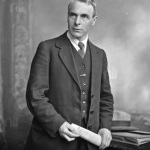
Thomas Johnson / Image courtesy of the National Library of Ireland
April 2018
In April 2018, we exhibited a copy of the Irish Labour Party general election manifesto published in September 1918. Despite the preparation of this manifesto, the Labour Party did not take part in the general election of 1918 or the parliamentary elections of 1921. This decision was taken to facilitate a clear-cut decision by the electorate on the national question and to avoid the possibility of a split in the labour movement which was organised on an all-Ireland basis.
During 1918, in anticipation of the forthcoming general election, the Irish Trade Union Congress and Labour Party reversed the order of its title to the Irish Labour Party and Trade Union Congress (ILP&TUC). It had more than doubled in strength to 250,000 members between the years 1916 and 1918.

Labour Party manifesto 1918 extract
Keeping up the momentum of the anti-conscription campaign from earlier in the year, the ILP&TUC Annual Congress, held at City Hall, Waterford on 5-7 August 1918, decided to draw up a manifesto for the upcoming general election as well as a new constitution. Both of these were to be presented to a Special Congress before the end of the year. Six weeks later the manifesto was published.
Special Congress
The Special Congress to decide on an election strategy and discuss the ILP&TUC manifesto was held in the Mansion House, Dublin, on 1-2 November 1918.

Delegates to the ILP&TUC Congress Waterford, 1918 / Image courtesy of the National Library of Ireland
Back in August 1918, when the National Executive decided to contest the forthcoming general election there was little sign of an early end to the war in Europe. The election was referred to as a ‘war election’ to be followed at the end of the war by dissolution and another election. In a matter of weeks, however, the war turned. Germany was on the retreat and peace was imminent. The election now became a ‘peace election’. With new republics being formed in Europe, the labour movement came under pressure to withdraw in order to allow a demonstration of unity on the issue of Irish self-determination. At the Sinn Féin Ard Fheis, held just two days before the Special Congress, speakers called for unity. Sean T O’Kelly was quoted in the Freeman's Journal saying that Labour should agree to stand aside and “let the election be fought on the clean issue of Ireland versus England”.
On the morning of the Special Congress, the National Executive met and recommended that the Labour Party should withdraw from the forthcoming general election. Later that day, Thomas Johnson, treasurer, on behalf of the National Executive, outlined the position to delegates (as quoted in the report of the conference, page 104):
“A call comes from all parts of Ireland for a demonstration of unity on this question, such as was witnessed on the Conscription issue. Your Executive believes that the workers of Ireland join earnestly in this desire, that they would willingly sacrifice, for a brief period, their aspirations towards political power if thereby the fortunes of the nation can be enhanced (applause).
"In the light of these new circumstances, the National Executive has reviewed the position and has decided to recommend the withdrawal from this Election of all Labour Candidates- (applause). They do so in the hope that the democratic demand for self-determination, to which the Irish Labour Party and its candidates give their unqualified adherence, will thereby obtain the freest chance of expression at the polls."
Mr Thomas McPartlin (Amalgamated Society of Carpenters and Joiners, Dublin) seconded the motion saying that he did so “solely influenced by the amount of good it would do in keeping the workers of Ireland united for the fight that would come in the future”.
The recommendation of the National Executive was accepted by the delegates.
References
Archives Exhibition by Irish Congress of Trade Unions and the National Archives of Ireland. Retrieved from http://centenaries-ituc.nationalarchives.ie/introduction/
Devoy-McAulliffe, F. (2017) The day when Irish labour found itself: the general strike against conscription in Crowley, J. Ó Drisceoil. D. and Murphy, M. (eds.) Atlas of the Irish Revolution, pp.330-334.
Farrell, B. (1970) Labour and the Irish political party system: A suggested approach to analysis, Economic and Social Review, 1 (4) pp. 477-509
Halligan, B. (1978) Snapshots: five days of Labour Party history. Retrieved from http://brendanhalligan.com/wp-content/uploads/2012/10/BH-5-Days-Labour-History-NC.pdf
O’Connor Lysaght, D. R. (2013) Labour in waiting: the after-effects of the Dublin lockout, History Ireland, 21 (4) July/August, pp. 44-47
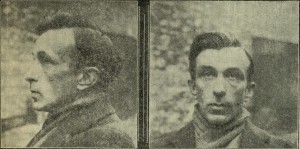
Roderick "Rory" O’Connor
March 2018
In March 2018, we showed an Irish issue of The Police Gazette or Hue-and-Cry from 25 March 1921. This issue illustrates the turmoil in Ireland at the time, following a sharp escalation of violence in the War of Independence at the end of 1920. The list of wanted "criminals" includes IRA leaders Michael Collins, Richard Mulcahy and Cathal Brugha along with the thief of a pony and cart in Co. Armagh and a man who embezzled a large sum from the Midleton Co-operative Society Stores in Co. Cork.

List of apprehensions sought on 25 March 1921
On the back page, further descriptions include that of republicans Rory O’Connor, who had recently escaped from the Curragh internment camp, and Dan Breen, whose dark complexion was likened to “a blacksmith emerging from a forge”. Breen had been on the wanted list since his involvement in an ambush in Soloheadbeg, Co. Tipperary on 21 January 1919, in which two policemen were killed. The ambush occurred on the same day that the First Dáil convened in Dublin and is considered by many to be the inciting incident of the war.

Roderick "Rory" O’Connor
The Police Gazette originated as something of an experiment in late 18th century London when the concept of policing was still very much in its infancy. Brothers Sir John Fielding and Henry Fielding, pioneers of criminal investigation, published advertisements calling on people to send them details of crimes committed and descriptions of the criminals involved. The crowd-sourced information was then published and distributed to local magistrates to assist with arrest and prosecution. The experiment proved very popular, and similar journals were printed for a number of years. Eventually it was decided to make the publication official and the London Metropolitan Police began publishing The Police Gazette or Hue-and-Cry twice weekly for distribution to police stations. In Ireland a special edition was circulated by the policing authorities in Dublin Castle.
Organised policing in Ireland began in the early 19th century with the establishment of the Irish Constabulary, and the Dublin Metropolitan Police, which operated as an unarmed civic force in Dublin city. Perceptions of the Irish Constabulary were mixed amongst the Irish population. Many nationalists associated it with British imperial administration, enforcing evictions and gathering intelligence. It was awarded the "Royal" prefix by Queen Victoria for its efforts to quash the Fenian Rising of 1867. But members of the Royal Irish Constabulary (RIC) were also well integrated with local communities. Many were from farming backgrounds and carried out civic and local government tasks such as taking the census. RIC members also rarely carried guns despite their status as an armed police force.

RIC members in Waterford 1917 (Image courtesy of the National Library of Ireland)
With the outbreak of the War of Independence in 1919, the RIC became an immediate target of the Irish Republican Army (IRA). The declaration of a boycott by the IRA and the provisional government, the setting up of the Dáil courts and intimidation of witnesses made the policing of ordinary crime very difficult. The situation was exacerbated considerably by the recruitment of ex-soldiers from Great Britain as RIC constables, who famously became known as the Black and Tans. At the same time a group of British ex-army officers were recruited as the Auxiliary Division of the RIC, a paramilitary force which became noted for reprisal killings and the burning of Cork city.
A truce was finally called on 11 July 1921 and the RIC was disbanded after the signing of the Anglo-Irish Treaty in 1922. It became the Civic Guard and finally An Garda Síochána, into which the Dublin Metropolitan Police was merged in 1925. In Northern Ireland the police force was renamed the Royal Ulster Constabulary.
Several Irish issues of The Police Gazette or Hue-and-Cry dating from 1915 to 1922 were transferred from Dublin Castle Library to the Oireachtas Library in the 1920s. You can view a digital copy of The Police Gazette or Hue-and-Cry from 25 March 1921 or search for other issues in our catalogue. (As the files are large, they may take some time to download)
Images
List of apprehensions sought on 25 March 1921
Roderick "Rory" O’Connor
RIC members in Waterford 1917 (Image courtesy of the National Library of Ireland)
References
Fedorowich, K. (1996) The problems of disbandment: the Royal Irish Constabulary and imperial migration, 1919-29. Irish Historical Studies, 30 (117) May, pp. 88-110.
Goodman, J. and Waddell, B. (1987) The black museum: Scotland Yard’s chamber of crime, London, Harrap
Hopkinson, M. (2002) The Irish War of Independence, Dublin, Gill and Macmillan
Leeson, D.M. (2011) The Black and Tans: British police and auxiliaries in the Irish War of Independence, Oxford, Oxford University Press
Pike, A.R. (1978) A Brief History of the Criminal Investigation Department of the London Metropolitan Police. Police Studies: Intnl Review of Police Development, 1 (2) June, pp. 22-30.
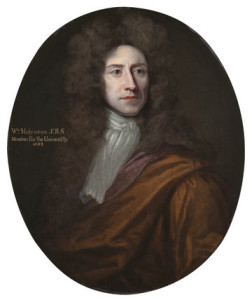
Portrait of William Molyneux by Sir Godfrey Kneller
February 2018
2018 marks the 320th anniversary of the death of William Molyneux, Irish writer, philosopher, scientist and member of the Irish Parliament in Dublin. Shortly before his death in 1698 he published a controversial pamphlet entitled The Case of Ireland’s being bound by Acts of Parliament in England, Stated.
During the latter half of the 17th century a series of laws had been passed by the English Parliament that damaged Irish trade and commerce – particularly the wool trade. Prompted by the increased regulation and by the writings of his great friend John Locke on human rights, Molyneux’s publication argued for Ireland’s autonomy in law-making:
“For tis the cause of the whole race of Adam that I argue: liberty seems the inherent right of all mankind.”
 Molyneux’s legal argument was founded on the basis that Ireland had not been taken by conquest in 1172, but by a voluntary submission of the Irish kings to Henry II, who had then granted them the right to a legislative parliament. There was no precedent, therefore, for the English Parliament to circumvent those long-established legislative rights since the mid 17th century. Though not intended by its author – who was arguing for ‘home rule’ rather than separation from England – the book proved highly controversial. The House of Commons of England condemned the publication as dangerous, and petitioned the king to punish Molyneux, but no action was taken. He died only a few months after its publication, in October 1698, and was buried in St Audoen’s Church in Dublin.
Molyneux’s legal argument was founded on the basis that Ireland had not been taken by conquest in 1172, but by a voluntary submission of the Irish kings to Henry II, who had then granted them the right to a legislative parliament. There was no precedent, therefore, for the English Parliament to circumvent those long-established legislative rights since the mid 17th century. Though not intended by its author – who was arguing for ‘home rule’ rather than separation from England – the book proved highly controversial. The House of Commons of England condemned the publication as dangerous, and petitioned the king to punish Molyneux, but no action was taken. He died only a few months after its publication, in October 1698, and was buried in St Audoen’s Church in Dublin.
The impact of the work was much greater than Molyneux could have anticipated, with reprints continuing throughout the following century and beyond. After the foundation of the Irish Free State the Oireachtas Library inherited five copies of the book from the Dublin Castle and London Irish Office libraries. References in the writings and speeches of prominent Irish Protestant figures, including Jonathan Swift and Henry Grattan, demonstrate its influence on the growing revolutionary consciousness of the 18th century.
References
Kelly, P. H. (2009) Molyneux (Molyneaux), William. In: McGuire, J. and Quinn, J. ed. Dictionary of Irish Biography. Cambridge, Cambridge University Press.
Kelly, P. (1988) William Molyneux and the Spirit of Liberty in Eighteenth-Century Ireland, Eighteenth-Century Ireland/Iris an Dá Chultúr, 3, pp.133-148.
Luce, J. V. (1986) William Molyneux of Dublin. Trinity Monday Memorial Discourse, accessible at https://www.tcd.ie/Secretary/FellowsScholars/discourses/discourses/1986a_J%20V%20Luce%20on%20W%20Molyneux.pdf
McBride, I. (2005) The nation in the age of revolution. In: Scales, L. and Zimmer, O. ed. Power and the Nation in European History. Cambridge: Cambridge University Press, pp.248-272.
Images
Front page of 1698 pamphlet

January 2018
The Conscription Crisis
In January 2018 we showed a copy of Ireland’s Case Against Conscription. The document was written by Éamon de Valera in 1918 and was published to support the campaign in Ireland to resist conscription during the First World War.
In early 1918, the British Army was short of troops for the western front and there were demands in the House of Commons and in the British media that conscription be extended to Ireland. On 17 January, a motion in the House of Commons to extend conscription to Ireland was defeated but, following the German spring offensive in which the British Army suffered a major setback, it was decided to introduce a new Military Service Bill to provide for the extension of conscription.
The Bill was passed in April 1918 and in response demonstrations were held throughout the country and an anti-conscription pledge was signed. The pledge was brought about by the Irish Anti-Conscription Committee, an alliance of leading Irish nationalists, including Éamon de Valera, John Dillon and Arthur Griffith. The move, which was supported by the Roman Catholic Church in Ireland and the labour movement, reflected the mood among the Irish public towards what had become an increasingly unpopular war. Anti-conscription support also came from women’s organisations including Cumann na mBan, whose members took a pledge not to fill the places of men forced into military service.


Images courtesy of the National Library of Ireland
On 23 April, a successful general strike against conscription was organized and led by the trade unions and the Labour Party. The mass mobilisation of resistance, as referenced in this contemporary ballad, ensured that conscription was never enforced.
At the height of the campaign against conscription, the British Government claimed that it had evidence of an alliance between Sinn Féin and Germany (the so-called "German plot"). While no evidence of such a plot was ever found, in May 1918 almost the entire leadership of Sinn Féin was arrested. The document on display was edited by Robert Brennan (then in charge of Sinn Féin publicity) who notes in the preface that Mr. de Valera intended to revise it before he was arrested and that “any apparent looseness of phraseology is attributable to the fact that this revision was interrupted”.
Further reading
Crowley, J. Ó Drisceoil. D. and Murphy, M. (eds.) (2017) Atlas of the Irish Revolution. See especially, Travers, P. ‘The conscription crisis and the general election of 1918’, pp 323-330, and Devoy-McAulliffe, F. ‘The day when Irish labour found itself: the general strike against conscription’, pp.330-334.
McAuliffe, M (2017), ‘The campaign against conscription 1818’ in History Ireland special supplement: 1916-18 Changed Utterly, pp. 46-48.
McCarthy, C. (2014), Cumann na mBan and the Irish Revolution.
Plunkett, H. (1918), Home Rule and Conscription.
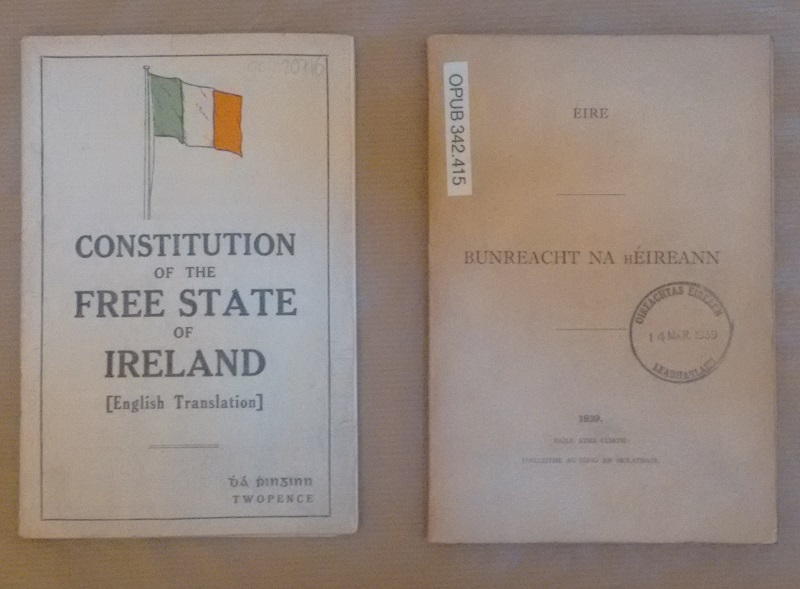
December 2017
Bunreacht na hÉireann and the Constitution of the Free State
In December 2017 we displayed early reprints of the modern Constitution of Ireland, Bunreacht na hÉireann, and its predecessor, the 1922 Constitution of the Free State.
Bunreacht na hÉireann
December 2017 marked 80 years since Bunreacht na hÉireann/Constitution of Ireland came into force following a plebiscite (referendum) on 1 July 1937. The question posed – “Do you approve of this draft constitution which is the subject of this plebiscite?” – was carried by 57% to 43% of the vote (10% of the votes were spoiled).
The new Constitution had been an important project of Eamon de Valera’s since Fianna Fáil came to power in 1932, and he supervised the drafting by the legal expert John Hearne and a team of civil servants.

The resulting Constitution was very much a representation of the nationalism and conservatism of the time, both in Ireland and in other European states (though arguments have been made that certain aspects, such as the explicit recognition of the Jewish congregation, were progressive for the time period). It has been amended 34 times, including removal of the reference to the “special position” of the Roman Catholic Church (1973) and the ban on divorce (1996) and continues to be a source of much debate in Ireland today.
Constitution of the Irish Free State
The 1922 Constitution had been written by a committee (pictured right) chaired by Michael Collins, after the Anglo-Irish Treaty was signed and in the run up to elections in June 1922. Consisting of a number of lawyers, civil servants, academics and businessmen, they met in the Shelbourne Hotel (which Collins considered a total extravagance by committee vice-chair Darrell Figgis) and produced several drafts within a few months.
The chosen draft, brought to London in May 1922, was an innovative document that horrified British officials with its strong emphasis on Irish sovereignty and the ‘Soviet’-like declaration that private property ownership was “subordinate to the public right and welfare of the Nation”. There was also a provision for ‘external ministers’, or unelected officials who could be granted a departmental portfolio.
The more revolutionary aspects were, unsurprisingly, rejected outright in London, and other elements watered down significantly, and a much compromised document was returned to Dublin by Collins and Griffith, where it was adopted by an Act of the Dáil in October 1922.
Power to make changes to the Free State Constitution lay in the hands of parliament and not the people (this was reversed in the 1937 document), and the Constitution was amended 27 times in the fifteen years of its existence. Once Fianna Fáil came to power in 1932, de Valera began removing the aspects most abhorrent to anti-Treaty proponents, including the oath of allegiance to the king, the right of Privy Council appeals, the post of Governor-General (the king’s representative in Ireland), and indeed any references to the king of England throughout the text. But the 1937 document retained many of the less controversial features of its predecessor.
References
Ó Tuama, S. (2011) Revisiting the Irish Constitution and De Valera’s Grand Vision. Irish Journal of Legal Studies, Vol. 2, No. 2, pp. 54-87
Mohr, T. (2008) British Involvement in the Creation of the First Irish Constitution. Dublin University Law Journal, Vol. 30 No. 1, pp. 166-186
Hogan, G, (2012) The 1937 Constitution. Address to the Constitutional Convention. Transcript.



